A Review of Piezoelectric Energy Harvesting: Materials, Design, and Readout Circuits
Abstract
1. Introduction
2. Materials
- Depolarization occurs when materials are exposed to the following conditions: high electric fields in the opposite direction of the polarizing field or high alternating electric fields.
- -
- Significant mechanical stresses;
- -
- Above the so-called Curie temperatures, a phase change in the crystal structure occurs, resulting in the loss of piezoelectric characteristics.
- Aging: the loss of piezoelectric capabilities with time as one advances away from the moment of polarization.
2.1. Piezoelectric Ceramics
2.2. Piezoelectric Polymers
2.3. Piezoelectric Composites
3. Piezoelectric Energy Harvester Configuration
- Cantilever beam;
- Circular diaphragm;
- Cymbal transducer;
- Stacked array type.
3.1. Cantilever Beam
3.2. Circular Diaphragm
3.3. Cymbal Transducer
3.4. Stacked and Array Structures
3.5. Other Innovative Configurations
4. Piezoelectric Harvesting Circuits
- The source G(t): expressed in the mechanical domain by the input vibration intensity;
- The inductor L: expressed in the mechanical domain by the equivalent inertial mass;
- The resistor R: expressed in the mechanical domain by the damping of the material composing the piezoelectric generator and other mechanical losses;
- The capacitor C: expressed in the mechanical domain by the elastic energy of the transducer;
- The capacitor Cp: the value of electrical capacitance measured between the two electrodes of the piezoelectric element.
4.1. Standard Energy Harvesting Circuit
4.2. Synchronized Switch Harvesting on Inductor (SSHI)
4.3. Synchronous Electrical Charge Extraction (SECE)
4.4. Pulsed Synchronous Charge Extractor (PSCE)
5. Energy Harvesting Technology Applications
6. Conclusions
Author Contributions
Funding
Data Availability Statement
Conflicts of Interest
References
- Shirvanimoghaddam, M.; Shirvanimoghaddam, K.; Abolhasani, M.M.; Farhangi, M.; Barsari, V.Z.; Liu, H.; Dohler, M.; Naebe, M. Towards a Green and Self-Powered Internet of Things Using Piezoelectric Energy Harvesting. IEEE Access 2019, 7, 94533–94556. [Google Scholar] [CrossRef]
- Won, S.S.; Seo, H.; Kawahara, M.; Glinsek, S.; Lee, J.; Kim, Y.; Jeong, C.K.; Kingon, A.I.; Kim, S.H. Flexible vibrational energy harvesting devices using strain-engineered perovskite piezoelectric thin films. Nano Energy 2019, 55, 182–192. [Google Scholar] [CrossRef]
- Sezer, N.; Koç, M. A comprehensive review on the state-of-the-art of piezoelectric energy harvesting. Nano Energy 2021, 80, 105567. [Google Scholar] [CrossRef]
- Brusa, E. Synopsis of the MBSE, Lean and Smart Manufacturing in the Product and Process Design for an Assessment of the Strategy “Industry 4.0”. In Proceedings of the INCOSE Italia Conference on Systems Engineering, Rome, Italy, 28–30 November 2018. [Google Scholar]
- Zhu, G.; Ren, P.; Hu, J.; Yang, J.; Jia, Y.; Chen, Z.; Ren, F.; Gao, J. Flexible and Anisotropic Strain Sensors with the Asymmetrical Cross-Conducting Network for Versatile Bio-Mechanical Signal Recognition. ACS Appl. Mater. Interfaces 2021, 13, 44925–44934. [Google Scholar] [CrossRef] [PubMed]
- Shabani, E.; Abdekhodaie, S.D.M.J. Laboratory detection methods for the human coronaviruses. Eur. J. Clin. Microbiol. Infect. Dis. 2021, 40, 225–246. [Google Scholar] [CrossRef] [PubMed]
- DeVore, A.D.; Wosik, J.; Hernandez, A.F. The Future of Wearables in Heart Failure Patients. JACC Heart Fail. 2019, 7, 922–932. [Google Scholar] [CrossRef]
- Rao, J.; Chen, Z.; Zhao, D.; Yin, Y.; Wang, X.; Yi, F. Recent Progress in Self-Powered Skin Sensors. Sensors 2019, 19, 2763. [Google Scholar] [CrossRef]
- Promphet, N.; Ummartyotin, S.; Ngeontae, W.; Puthongkham, P.; Rodthongkum, N. Non-invasive wearable chemical sensors in real-life applications. Anal. Chim. Acta 2021, 1179, 338643. [Google Scholar] [CrossRef]
- Kamišalić, A.; Fister, I.; Turkanović, M.; Karakatič, S. Sensors and Functionalities of Non-Invasive Wrist-Wearable Devices: A Review. Sensors 2018, 18, 1714. [Google Scholar] [CrossRef]
- Khan, Y.; Ostfeld, A.E.; Lochner, C.M.; Pierre, A.; Arias, A.C. Monitoring of Vital Signs with Flexible and Wearable Medical Devices. Adv. Mater. 2016, 28, 4373–4395. [Google Scholar] [CrossRef]
- Kim, H.S.; Kim, J.H.; Kim, J. A Review of Piezoelectric Energy Harvesting Based on Vibration. Int. J. Precis. Eng. Manuf. 2011, 12, 1129–1141. [Google Scholar] [CrossRef]
- Pawar, O.Y.; Patil, S.L.; Redekar, R.S.; Patil, S.B.; Lim, S.; Tarwal, N.L. Strategic Development of Piezoelectric Nanogenerator and Biomedical Applications. Appl. Sci. 2023, 13, 2891. [Google Scholar] [CrossRef]
- Zhao, Z.; Dai, Y.; Dou, S.; Liang, J. Flexible nanogenerators for wearable electronic applications based on piezoelectric materials. Mater. Today Energy 2021, 20, 100690. [Google Scholar] [CrossRef]
- Yang, Z.; Zhu, Z.; Chen, Z.; Liu, M.; Zhao, B.; Liu, Y.; Cheng, Z.; Wang, S.; Yang, W.; Yu, T. Recent Advances in Self-Powered Piezoelectric and Triboelectric Sensors: From Material and Structure Design to Frontier Applications of Artificial Intelligence. Sensors 2021, 21, 8422. [Google Scholar] [CrossRef]
- Fan, F.R.; Tian, Z.Q.; Lin Wang, Z. Flexible triboelectric generator. Nano Energy 2012, 1, 328–334. [Google Scholar] [CrossRef]
- Zou, J.; Zhang, M.; Huang, J.; Bian, J.; Jie, Y.; Willander, M.; Cao, X.; Wang, N.; Wang, Z.L. Coupled Supercapacitor and Triboelectric Nanogenerator Boost Biomimetic Pressure Sensor. Adv. Energy Mater. 2018, 8, 1702671. [Google Scholar] [CrossRef]
- Kuang, S.; Suo, X.; Song, P.; Luo, J. Instantaneous Self-Powered Sensing System Based on Planar-Structured Rotary Triboelectric Nanogenerator. Sensors 2021, 21, 3741. [Google Scholar] [CrossRef] [PubMed]
- Toroń, B.; Mistewicz, K.; Jesionek, M.; Kozioł, M.; Zubko, M.; Stróż, D. A new hybrid piezo/triboelectric SbSeI nanogenerator. Energy 2022, 238, 122048. [Google Scholar] [CrossRef]
- Xue, H.; Yang, Q.; Wang, D.; Luo, W.; Wang, W.; Lin, M.; Liang, D.; Luo, Q. A wearable pyroelectric nanogenerator and self-powered breathing sensor. Nano Energy 2017, 38, 147–154. [Google Scholar] [CrossRef]
- Korkmaz, S.; Kariper, I.A. Pyroelectric nanogenerators (PyNGs) in converting thermal energy into electrical energy: Fundamentals and current status. Nano Energy 2021, 84, 105888. [Google Scholar] [CrossRef]
- Yang, Y.; Guo, W.; Pradel, K.C.; Zhu, G.; Zhou, Y.; Zhang, Y.; Hu, Y.; Lin, L.; Wang, Z.L. Pyroelectric Nanogenerators for Harvesting Thermoelectric Energy. Nano Lett. 2012, 12, 2833–2838. [Google Scholar] [CrossRef]
- Lee, M.; Teuscher, J.; Miyasaka, T.; Murakami, T.; Im, J.H. Efficient Hybrid Solar Cells Based on Meso-Superstructured Organometal Halide Perovskites. Science 2012, 338, 643–647. [Google Scholar] [CrossRef]
- Yoon, G.C.; Shin, K.S.; Gupta, M.K.; Lee, K.Y.; Lee, J.H.; Wang, Z.L.; Kim, S.W. High-performance hybrid cell based on an organic photovoltaic device and a direct current piezoelectric nanogenerator. Nano Energy 2015, 12, 547–555. [Google Scholar] [CrossRef]
- Rabaey, J.; Ammer, M.; da Silva, J.; Patel, D.; Roundy, S. PicoRadio supports ad hoc ultra-low power wireless networking. Computer 2000, 33, 42–48. [Google Scholar] [CrossRef]
- Khalid, A.; Redhewal, A.; Kumar, M.; Srivastav, A. Piezoelectric Vibration Harvesters Based on Vibrations of Cantilevered Bimorphs: A Review. Mater. Sci. Appl. 2015, 6, 818–827. [Google Scholar] [CrossRef][Green Version]
- Holmes, J. Trajectories of spheres in strong winds with application to wind-borne debris. J. Wind Eng. Ind. Aerodyn. 2004, 92, 9–22. [Google Scholar] [CrossRef]
- Raghunathan, V.; Kansal, A.; Hsu, J.; Friedman, J.; Srivastava, M. Design considerations for solar energy harvesting wireless embedded systems. In Proceedings of the IPSN 2005. Fourth International Symposium on Information Processing in Sensor Networks, Boise, ID, USA, 15 April 2005; pp. 457–462. [Google Scholar] [CrossRef]
- Paradiso, J.; Starner, T. Energy scavenging for mobile and wireless electronics. IEEE Pervasive Comput. 2005, 4, 18–27. [Google Scholar] [CrossRef]
- Stevens, J.W. Optimized Thermal Design of Small ΔT Thermoelectric Generators. In Proceedings of the 34th Intersociety Energy Conversion Engineering Conference, Vancouver, BC, Canada, 2–5 August 1999; p. 8. [Google Scholar] [CrossRef]
- Beeby, S.P.; Tudor, M.J.; White, N.M. Energy harvesting vibration sources for microsystems applications. Meas. Sci. Technol. 2006, 17, R175. [Google Scholar] [CrossRef]
- Beeby, S.; Torah, R.; Tudor, M.; Glynne-Jones, P.; O’Donnell, T.; Saha, C.; Roy, S. Micro electromagnetic generator for vibration energy harvesting. J. Micromech. Microeng. 2007, 17, 1257. [Google Scholar] [CrossRef]
- Delprete, C.; Brusa, E.; Tonoli, A. Modeling for self-sensing electromechanical systems. In Proceedings of the 3rd International Conference on Motion and Vibration Control MOVIC’96, Chiba, Japan, 1–6 September 1996; pp. 117–122. [Google Scholar]
- Pasquale, G.D.; Brusa, E.; Soma, A. Capacitive vibration energy harvesting with resonance tuning. In Proceedings of the 2009 Symposium on Design, Test, Integration & Packaging of MEMS/MOEMS, Rome, Italy, 1–3 April 2009; pp. 280–285. [Google Scholar]
- Erturk, A.; Inman, D.J. Introduction to Piezoelectric Energy Harvesting. In Piezoelectric Energy Harvesting; John Wiley & Sons, Ltd.: Hoboken, NJ, USA, 2011; Chapter 1; pp. 1–18. [Google Scholar] [CrossRef]
- Madinei, H.; Khodaparast, H.H.; Adhikari, S.; Friswell, M. Design of MEMS piezoelectric harvesters with electrostatically adjustable resonance frequency. Mech. Syst. Signal Process. 2016, 81, 360–374. [Google Scholar] [CrossRef]
- Zhou, X.; Parida, K.; Halevi, O.; Liu, Y.; Xiong, J.; Magdassi, S.; Lee, P.S. All 3D-printed stretchable piezoelectric nanogenerator with non-protruding kirigami structure. Nano Energy 2020, 72, 104676. [Google Scholar] [CrossRef]
- Chen, J.; Oh, S.K.; Nabulsi, N.; Johnson, H.; Wang, W.; Ryou, J.H. Biocompatible and sustainable power supply for self-powered wearable and implantable electronics using III-nitride thin-film-based flexible piezoelectric generator. Nano Energy 2019, 57, 670–679. [Google Scholar] [CrossRef]
- Brusa, E.; Carabelli, S.; Carraro, F.; Tonoli, A. Electromechanical Tuning of Self-Sensing Piezoelectric Transducers. J. Intell. Mater. Syst. Struct. 1998, 9, 198–209. [Google Scholar] [CrossRef]
- Wu, N.; Wang, Q.; Xie, X. Ocean wave energy harvesting with a piezoelectric coupled buoy structure. Appl. Ocean Res. 2015, 50, 110–118. [Google Scholar] [CrossRef]
- Sun, Y.; Chen, J.; Li, X.; Lu, Y.; Zhang, S.; Cheng, Z. Flexible piezoelectric energy harvester/sensor with high voltage output over wide temperature range. Nano Energy 2019, 61, 337–345. [Google Scholar] [CrossRef]
- Brusa, E. Design of a kinematic vibration energy harvester for a smart bearing with piezoelectric/magnetic coupling. Mech. Adv. Mater. Struct. 2018, 27, 1322–1330. [Google Scholar] [CrossRef]
- Anton, S.; Sodano, H. A Review of Power Harvesting Using Piezoelectric Materials (2003–2006). Smart Mater. Struct. 2007, 16, R1. [Google Scholar] [CrossRef]
- Covaci, C.; Gontean, A. Piezoelectric energy harvesting solutions: A review. Sensors 2020, 20, 3512. [Google Scholar] [CrossRef]
- Erturk, A.; Inman, D.J. An experimentally validated bimorph cantilever model for piezoelectric energy harvesting from base excitations. Smart Mater. Struct. 2009, 18, 025009. [Google Scholar] [CrossRef]
- Liu, H.; Zhong, J.; Lee, C.; Lee, S.W.; Lin, L. A comprehensive review on piezoelectric energy harvesting technology: Materials, mechanisms, and applications. Appl. Phys. Rev. 2018, 5, 041306. [Google Scholar] [CrossRef]
- Habib, M.; Lantgios, I.; Hornbostel, K. A review of ceramic, polymer and composite piezoelectric materials. J. Phys. D Appl. Phys. 2022, 55, 423002. [Google Scholar] [CrossRef]
- Zhou, Q.; Lam, K.H.; Zheng, H.; Qiu, W.; Shung, K.K. Piezoelectric single crystal ultrasonic transducers for biomedical applications. Prog. Mater. Sci. 2014, 66, 87–111. [Google Scholar] [CrossRef] [PubMed]
- Dawson, L.H. Piezoelectricity of Crystal Quartz. Phys. Rev. 1927, 29, 532–541. [Google Scholar] [CrossRef]
- Haraoubia, B. 3—High-frequency Oscillators. In Nonlinear Electronics 1; Haraoubia, B., Ed.; Elsevier: Amsterdam, The Netherlands, 2018; pp. 125–169. [Google Scholar] [CrossRef]
- Bunde, R.L.; Jarvi, E.J.; Rosentreter, J.J. Piezoelectric quartz crystal biosensors. Talanta 1998, 46, 1223–1236. [Google Scholar] [CrossRef]
- Dye, D.W. The piezo-electric quartz resonator and its equivalent electrical circuit. Proc. Phys. Soc. Lond. 1925, 38, 399. [Google Scholar] [CrossRef]
- Nicolson, A.M. The Piezo Electric Effect in the Composite Rochelle Salt Crystal. Trans. Am. Inst. Electr. Eng. 1919, XXXVIII, 1467–1493. [Google Scholar] [CrossRef]
- Andrusyk, A. Piezoelectric Effect in Rochelle Salt. In Ferroelectrics—Physical Effects; IntechOpen: London, UK, 2011. [Google Scholar] [CrossRef]
- Shur, V. Nano- and Microdomain Engineering of Lithium Niobate and Lithium Tantalate for Piezoelectric Applications. In Advanced Piezoelectric Materials, 2nd ed.; Uchino, K., Ed.; Woodhead Publishing: Sawston, UK, 2017; pp. 235–270. [Google Scholar] [CrossRef]
- Uchino, K. The Development of Piezoelectric Materials and the New Perspective. In Advanced Piezoelectric Materials, 2nd ed.; Uchino, K., Ed.; Woodhead Publishing: Sawston, UK, 2017; pp. 1–92. [Google Scholar] [CrossRef]
- Yamada, T.; Niizeki, N.; Toyoda, H. Piezoelectric and Elastic Properties of Lithium Niobate Single Crystals. Jpn. J. Appl. Phys. 1967, 6, 151. [Google Scholar] [CrossRef]
- Safaei, M.; Sodano, H.A.; Anton, S.R. A review of energy harvesting using piezoelectric materials: State-of-the-art a decade later (2008–2018). Smart Mater. Struct. 2019, 28, 113001. [Google Scholar] [CrossRef]
- Wu, W.; Bai, S.; Miaomiao, Y.; Qin, Y.; Wang, Z.; Jing, T. Lead Zirconate Titanate Nanowire Textile Nanogenerator for Wearable Energy-Harvesting and Self-Powered Devices. ACS Nano 2012, 6, 6231–6235. [Google Scholar] [CrossRef]
- Likhon, M.M.; Shawan, S.I.; Alam, M.N.S.B.; Siddique, S. Characterizing Piezoelectric Properties of PZT-4, PZT-5A, PZT-5J, PZT-7A and Lithium Tantalate Material-based Transducers. In Proceedings of the International Conference on Green Energy, Computing and Sustainable Technology, GECOST 2021, Miri, Malaysia, 7–9 July 2021. [Google Scholar]
- Sunithamani, S.; Lakshmi, P.; Flora, E.E. PZT length optimization of MEMS piezoelectric energy harvester with a non-traditional cross section: Simulation study. Microsyst. Technol. 2013, 20, 2165–2171. [Google Scholar] [CrossRef]
- Naduvinamani, S.; Iyer, N.C. Design and simulation of PZT based MEMS piezoelectric accelerometer. In Proceedings of the International Conference on Electrical, Electronics, and Optimization Techniques, ICEEOT 2016, Chennai, India, 3–5 March 2016; pp. 3715–3721. [Google Scholar]
- Huang, J.; Yao, M.; Yao, X. A novel approach to improving the electromechanical properties of PZT-based piezoelectric ceramics via a grain coating modification strategy. Ceram. Int. 2021, 47, 16294–16302. [Google Scholar] [CrossRef]
- Mengwei, L.; Tianhong, C.; Weijie, D.; Yan, C.; Jing, W.; Liqun, D.; Liding, W. Piezoelectric microcantilevers with Two PZT thin-film elements for microsensors and microactuators. In Proceedings of the 1st IEEE International Conference on Nano Micro Engineered and Molecular Systems, Zhuhai, China, 18–21 January 2006; pp. 775–778. [Google Scholar]
- Kanno, I. Piezoelectric Pzt Thin Films: Deposition, Evaluation and Their Applications. In Proceedings of the 2019 20th International Conference on Solid-State Sensors, Actuators and Microsystems & Eurosensors XXXIII (TRANSDUCERS & EUROSENSORS XXXIII), Berlin, Germany, 23–27 June 2019; pp. 785–788. [Google Scholar] [CrossRef]
- Low, T.; Guo, W. Modeling of a three-layer piezoelectric bimorph beam with hysteresis. J. Microelectromech. Syst. 1995, 4, 230–237. [Google Scholar] [CrossRef]
- Butt, Z.; Pasha, A.; Qayyum, F.; Anjum, Z.; Ahmad, N.; Elahi, H. Generation of electrical energy using lead zirconate titanate (PZT-5A) piezoelectric material: Analytical, numerical and experimental verifications. J. Mech. Sci. Technol. 2016, 30, 3553–3558. [Google Scholar] [CrossRef]
- Zhu, X. Piezoelectric ceramic materials: Processing, properties, characterization, and applications. In Piezoelectric Materials: Structure, Properties and Applications; Nova Science Publishers: Hauppauge, NY, USA, 2010; pp. 1–36. [Google Scholar]
- Huisman, J.; Magalini, F.; Kuehr, R.; Maurer, C.; Ogilvie, S.; Poll, J.; Delgado, C.; Artim, E.; Szlezak, J.; Stevels, A. Review of Directive 2002/96 on Waste Electrical and Electronic Equipment (WEEE); United Nations University: Tokyo, Japan, 2008; Volume 37. [Google Scholar]
- Shrout, T.; Zhang, S. Lead-Free Piezoelectric Ceramics: Alternatives for PZT? J. Electroceram. 2007, 19, 113–126. [Google Scholar] [CrossRef]
- Akdogan, E.; Kerman, K.; Abazari, M.; Safari, A. Origin of High Piezoelectric Activity in Ferroelectric (K0.44Na0.52Li0.04)-(Nb0.84Ta0.1Sb0.06)O3 Ceramics. Appl. Phys. Lett. 2008, 92, 112908. [Google Scholar] [CrossRef]
- Carreño-Jiménez, B.; Benítez-Benítez, J.L.; Castañeda-Guzmán, R.; Acuautla, M.; López-Juárez, R. Lead-free KNN-based thin films obtained by pulsed laser deposition. In Proceedings of the 2022 IEEE International Symposium on Applications of Ferroelectrics (ISAF), Tours, France, 27 June–1 July 2022; pp. 1–4. [Google Scholar] [CrossRef]
- Saito, Y.; Takao, H.; Tani, T.; Nonoyama, T.; Takatori, K.; Homma, T.; Nagaya, T.; Nakamura, M. Lead-free piezoceramics. Nature 2004, 432, 84–87. [Google Scholar] [CrossRef] [PubMed]
- Smeltere, I.; Antonova, M.; Dunce, M.; Livinsh, M.; Garbarz-Glos, B. Electrical and mechanical properties of KNN based lead-free ceramics. In Proceedings of the 12th Conference of the European Ceramic Society—ECerS XII, Stockholm, Sweden, 19–23 June 2011. [Google Scholar]
- Rodel, J.; Jo, W.; Seifert, K.; Anton, E.M.; Granzow, T.; Damjanovic, D. Perspective on the Development of Lead-Free Piezoceramics. J. Am. Ceram. Soc. 2009, 92, 1153–1177. [Google Scholar] [CrossRef]
- Li, P.; Huan, Y.; Yang, W.; Zhu, F.; Li, X.; Zhang, X.; Shen, B.; Zhai, J. High-performance potassium-sodium niobate lead-free piezoelectric ceramics based on polymorphic phase boundary and crystallographic texture. Acta Mater. 2018, 165, 486–495. [Google Scholar] [CrossRef]
- Acosta, M.; Novak, N.; Rojas, V.; Patel, S.; Vaish, R.; Koruza, J.; Rossetti, G.A., Jr.; Rödel, J. BaTiO3-based piezoelectrics: Fundamentals, current status, and perspectives. Appl. Phys. Rev. 2017, 4, 041305. [Google Scholar] [CrossRef]
- Baek, C.; Park, H.; Yun, J.H.; Kim, D.K.; Park, K.I. Lead-free BaTiO3 Nanowire Arrays-based Piezoelectric Energy Harvester. MRS Adv. 2017, 2, 1–6. [Google Scholar] [CrossRef]
- Hiruma, Y.; Nagata, H.; Takenaka, T. Thermal Depoling Process and Piezoelectric Properties of Bismuth Sodium Titanate Ceramics. J. Appl. Phys. 2009, 105, 084112. [Google Scholar] [CrossRef]
- Safari, A.; Abazari, M. Lead-Free Piezoceramic Ceramics and Thin Films. Ultrason. Ferroelectr. Freq. Control IEEE Trans. 2010, 57, 2165–2176. [Google Scholar] [CrossRef] [PubMed]
- Reichmann, K.; Feteira, A.; Li, M. Bismuth Sodium Titanate Based Materials for Piezoelectric Actuators. Materials 2015, 8, 8467–8495. [Google Scholar] [CrossRef] [PubMed]
- Gao, J.; Xue, D.; Liu, W.; Zhou, C.; Ren, X. Recent Progress on BaTiO3-Based Piezoelectric Ceramics for Actuator Applications. Actuators 2017, 6, 24. [Google Scholar] [CrossRef]
- Karaki, T.; Yan, K.; Miyamoto, T.; Adachi, M. Lead-Free Piezoelectric Ceramics with Large Dielectric and Piezoelectric Constants Manufactured from BaTiO3 Nano-Powder. Jpn. J. Appl. Phys. 2007, 46, L97–L98. [Google Scholar] [CrossRef]
- Liu, W.; Ren, X. Large Piezoelectric Effect in Pb-Free Ceramics. Phys. Rev. Lett. 2009, 103, 257602. [Google Scholar] [CrossRef] [PubMed]
- He, H.; Lu, W.; Oh, J.A.S.; Li, Z.; Lu, X.; Zeng, K.; Lu, L. Probing the Coexistence of Ferroelectric and Relaxor State in Bi0.5Na0.5TiO3-Based Ceramics for Enhanced Piezoelectric Performance. Acs Appl. Mater. Interfaces 2020, 12, 30548–30556. [Google Scholar] [CrossRef]
- Matsumoto, K.; Hiruma, Y.; Nagata, H.; Takenaka, T. Piezoelectric Properties of KNbO3 Ceramics Prepared by Ordinary Sintering. Ferroelectrics 2007, 358, 169–174. [Google Scholar] [CrossRef]
- Nakamura, K.; Tokiwa, T.; Kawamura, Y. Domain structures in KNbO3 crystals and their piezoelectric properties. J. Appl. Phys. 2002, 91, 9272–9276. [Google Scholar] [CrossRef]
- Wada, S.; Seike, A.; Tsurumi, T. Poling Treatment and Piezoelectric Properties of Potassium Niobate Ferroelectric Single Crystals. Jpn. J. Appl. Phys. 2001, 40, 5690–5697. [Google Scholar] [CrossRef]
- Guan, S.; Yang, H.; Cheng, S.; Wang, X.; Sun, Y.; Yang, X.; Tan, H.; Zhang, H. Phase structure, domain structure, thermal stability, and high-temperature piezoelectric response of BiFeO3–BaTiO3 lead-free piezoelectric ceramics. Ceram. Int. 2023, 50, 384–393. [Google Scholar] [CrossRef]
- Neaton, J.; Ederer, C.; Waghmare, U.; Spaldin, N.; Rabe, K. First-Principles Study of Spontaneous Polarization in Multiferroic BiFeO3. Phys. Rev. B 2004, 71, 014113. [Google Scholar] [CrossRef]
- Wu, J.; Fan, Z.; Xiao, D.; Zhu, J.; Wang, J. Multiferroic bismuth ferrite-based materials for multifunctional applications: Ceramic bulks, thin films and nanostructures. Prog. Mater. Sci. 2016, 84, 335–402. [Google Scholar] [CrossRef]
- Gerfers, F.; Kohlstadt, P.; Ginsburg, E.; He, M.; Samara-Rubio, D.; Manoli, Y.; Wang, L. Sputtered AlN Thin Films for Piezoelectric MEMS Devices—FBAR Resonators and Accelerometers; IntechOpen: London, UK, 2010. [Google Scholar] [CrossRef]
- Guy, I.; Muensit, N.; Goldys, E. Extensional Piezoelectric Coefficients of Gallium Nitride and Aluminum Nitride. Appl. Phys. Lett. 2000, 75, 4133–4135. [Google Scholar] [CrossRef]
- Tittmann, B.R.; Parks, D.A.; Zhang, S. High Temperature Piezoelectrics—A Comparison. In Proceedings of the 13th International Symposium on Nondestructive Characterization of Materials (NDCM-XIII), Le Mans, France, 20–24 May 2013. [Google Scholar]
- Yarar, E.; Hrkac, V.; Zamponi, C.; Piorra, A.; Kienle, L.; Quandt, E. Low temperature aluminum nitride thin films for sensory applications. AIP Adv. 2016, 6, 075115. [Google Scholar] [CrossRef]
- Ahmad, M.A.; Plana, R. Vertical displacement detection of an aluminum nitride piezoelectric thin film using capacitance measurements. Int. J. Microw. Wirel. Technol. 2009, 1, 5–9. [Google Scholar] [CrossRef]
- Wang, R.; Bhave, S.A.; Bhattacharjee, K. Design and Fabrication of S0 Lamb-Wave Thin-Film Lithium Niobate Micromechanical Resonators. J. Microelectromech. Syst. 2015, 24, 300–308. [Google Scholar] [CrossRef]
- Plessky, V.; Yandrapalli, S.; Turner, P.; Villanueva, L.G.; Koskela, J.; Hammond, R. 5 GHz laterally-excited bulk-wave resonators (XBARs) based on thin platelets of Lithium Niobate. Electron. Lett. 2019, 55, 98–100. [Google Scholar] [CrossRef]
- Yang, Y.; Lu, R.; Manzaneque, T.; Gong, S. Toward Ka Band Acoustics: Lithium Niobate Asymmetrical Mode Piezoelectric MEMS Resonators. In Proceedings of the 2018 IEEE International Frequency Control Symposium (IFCS), Olympic Valley, CA, USA, 21–24 May 2018; pp. 1–5. [Google Scholar] [CrossRef]
- Yamada, T.; Iwasaki, H.; Niizeki, N. Piezoelectric and Elastic Properties of LiTaO3: Temperature Characteristics. Jpn. J. Appl. Phys. 1969, 8, 1127. [Google Scholar] [CrossRef]
- Bartasyte, A.; Margueron, S.; Baron, T.; Oliveri, S.; Boulet, P. Toward High-Quality Epitaxial LiNbO3 and LiTaO3 Thin Films for Acoustic and Optical Applications. Adv. Mater. Interfaces 2017, 4, 1600998. [Google Scholar] [CrossRef]
- Yamashita, Y.Y.Y. Large Electromechanical Coupling Factors in Perovskite Binary Material System. Jpn. J. Appl. Phys. 1994, 33, 5328. [Google Scholar] [CrossRef]
- Agrawal, R.; Horacio, D. Giant Piezoelectric Size Effects in Zinc Oxide and Gallium Nitride Nanowires. A First Principles Investigation. Nano Lett. 2011, 11, 786–790. [Google Scholar] [CrossRef] [PubMed]
- Zhou, J.; Fei, P.; Gao, Y.; Gu, Y.; Liu, J.; Bao, G.; Wang, Z. Mechanical–Electrical Triggers and Sensors Using Piezoelectric Micowires/Nanowires. Nano Lett. 2008, 8, 2725–2730. [Google Scholar] [CrossRef] [PubMed]
- Kou, L.z.; Guo, W.l.; Li, C. Piezoelectricity of ZnO and its nanostructures. In Proceedings of the 2008 Symposium on Piezoelectricity, Acoustic Waves, and Device Applications, Nanjing, China, 5–8 December 2008; pp. 354–359. [Google Scholar] [CrossRef]
- Wang, Z.L.; Song, J. Piezoelectric Nanogenerators Based on Zinc Oxide Nanowire Arrays. Science 2006, 312, 242–246. [Google Scholar] [CrossRef] [PubMed]
- Khudiar, A.; Khalaf, M.; Ofui, A. Improvement of the sensing characterizations of ZnO nanostructure by using thermal annealing prepared through R. F. magnetron sputtering technique. Opt. Mater. 2021, 114, 110885. [Google Scholar] [CrossRef]
- Ayman, M. The enhancement of nonlinear absorption of Zn/ZnO thin film by creation oxygen vacancies via infrared laser irradiation and coating with Ag thin film via pulsed laser deposition. J. Mol. Struct. 2021, 1226, 129407. [Google Scholar] [CrossRef]
- Alanthattil, A.; Patil, P.; Gummagol, N.; Goutam, U.; Sharma, P.; B V, R. Microstructural, linear and nonlinear optical study of spray pyrolysed nanostructured La–ZnO thin film: An effect of deposition temperature. Opt. Mater. 2021, 122, 111742. [Google Scholar] [CrossRef]
- Wang, J.; He, Y.c.; Luo, T.C.; Li, Y.; Zhou, Z.; Fan, B.f.; Li, J.; Wang, G. Simulation and experimental verification study on the process parameters of ZnO-MOCVD. Ceram. Int. 2021, 47, 15471–15482. [Google Scholar] [CrossRef]
- Li, Q.; Ying, M.; Zhang, M.; Cheng, W.; Li, W.; Liao, B.; Zhang, x. Structural characterization and surface polarity determination of polar ZnO films prepared by MBE. Appl. Nanosci. 2021, 13, 3197–3204. [Google Scholar] [CrossRef]
- Cholleti, E. A Review on 3D printing of piezoelectric materials. IOP Conf. Ser. Mater. Sci. Eng. 2018, 455, 012046. [Google Scholar] [CrossRef]
- Sappati, K.K.; Bhadra, S. Piezoelectric Polymer and Paper Substrates: A Review. Sensors 2018, 18, 3605. [Google Scholar] [CrossRef] [PubMed]
- Fotouhi, S.; Akrami, R.; Ferreira-Green, K.; Naser, G.A.M.; Fotouhi, M.; Fragassa, C. Piezoelectric PVDF sensor as a reliable device for strain/load monitoring of engineering structures. IOP Conf. Ser. Mater. Sci. Eng. 2019, 659, 012085. [Google Scholar] [CrossRef]
- Koga, K.; Ohigashi, H. Piezoelectricity and related properties of vinylidene fluoride and trifluoroethylene copolymers. J. Appl. Phys. 1986, 59, 2142–2150. [Google Scholar] [CrossRef]
- Elahi, H.; Eugeni, M.; Gaudenzi, P. A Review on Mechanisms for Piezoelectric-Based Energy Harvesters. Energies 2018, 11, 1850. [Google Scholar] [CrossRef]
- Ruan, L.; Yao, X.; Chang, Y.; Zhou, L.; Qin, G.; Zhang, X. Properties and Applications of the β Phase Poly(vinylidene fluoride). Polymers 2018, 10, 228. [Google Scholar] [CrossRef]
- Sajkiewicz, P. Crystallization behaviour of poly(vinylidene fluoride). Eur. Polym. J. 1999, 35, 1581–1590. [Google Scholar] [CrossRef]
- Gradys, A.; Sajkiewicz, P.; Adamovsky, S.; Minakov, A.; Schick, C. Crystallization of poly(vinylidene fluoride) during ultra-fast cooling. Thermochim. Acta 2007, 461, 153–157. [Google Scholar] [CrossRef]
- Siddiqui, S.; Kim, D.I.; Roh, E.; Duy, L.T.; Trung, T.Q.; Nguyen, M.T.; Lee, N.E. A Durable and Stable Piezoelectric Nanogenerator with Nanocomposite Nanofibers Embedded in an Elastomer under High Loading for a Self-Powered Sensor System. Nano Energy 2016, 30, 434–442. [Google Scholar] [CrossRef]
- Jain, A.; Kumar, J.; Mahapatra, D.; Rathod, V. Development of P(VDF-Trfe) Films and Its Quasi-Static and Dynamic Strain Response; IJERT: Gandhinagar, India, 2013. [Google Scholar]
- Dahiya, R.; Valle, M.; Metta, G.; Lorenzelli, L.; Pedrotti, S. Deposition, processing and characterization of P(VDF-TrFE) thin films for sensing applications. In Proceedings of the SENSORS, 2008 IEEE, Lecce, Italy, 26–29 October 2008; pp. 490–493. [Google Scholar] [CrossRef]
- Fang, F.; Shan, S.C.; Yang, W. A multipeak phenomenon of magnetoelectric coupling in Terfenol-D/P(VDF-TrFE)/Terfenol-D laminates. J. Appl. Phys. 2010, 108, 104505. [Google Scholar] [CrossRef]
- Lovinger, A.J. Ferroelectric transition in a copolymer of vinylidene fluoride and tetrafluoroethylene. Macromolecules 1983, 16, 1529–1534. [Google Scholar] [CrossRef]
- Lovinger, A.J.; Davis, D.D.; Cais, R.E.; Kometani, J.M. Compositional variation of the structure and solid-state transformations of vinylidene fluoride/tetrafluoroethylene copolymers. Macromolecules 1988, 21, 78–83. [Google Scholar] [CrossRef]
- Lovinger, A.J.; Johnson, G.E.; Bair, H.E.; Anderson, E.W. Structural, dielectric, and thermal investigation of the Curie transition in a tetrafluoroethylene copolymer of vinylidene fluoride. J. Appl. Phys. 1984, 56, 2412–2418. [Google Scholar] [CrossRef]
- Green, J.; Rabolt, J.F. Identification of a Curie transition in vinylidene fluoride/tetrafluoroethylene random copolymers by spectroscopic methods. Macromolecules 1987, 20, 456–457. [Google Scholar] [CrossRef]
- Lando, J.B.; Doll, W.W. The polymorphism of poly(vinylidene fluoride). I. The effect of head-to-head structure. J. Macromol. Sci. Part B 1968, 2, 205–218. [Google Scholar] [CrossRef]
- Nalwa, H.S. Crystal Structure and Phase Transition of PVDF and Related Copolymers; CRC Press: Boca Raton, FL, USA, 1995. [Google Scholar]
- Lovinger, A.J. Ferroelectric Polymers. Science 1983, 220, 1115–1121. [Google Scholar] [CrossRef]
- Tai, Y.; Yang, S.; Yu, S.; Banerjee, A.; Myung, N.; Nam, J. Modulation of piezoelectric properties in electrospun PLLA nanofibers for application-specific self-powered stem cell culture platforms. Nano Energy 2021, 89, 106444. [Google Scholar] [CrossRef]
- Li, J.; Long, Y.; Yang, F.; Wang, X. Degradable Piezoelectric Biomaterials for Wearable and Implantable Bioelectronics. Curr. Opin. Solid State Mater. Sci. 2020, 24, 100806. [Google Scholar] [CrossRef]
- Bajpai, A.K.; Bajpai, J.; Saini, R.; Gupta, R. Responsive Polymers in Biology and Technology. Polym. Rev. 2011, 51, 53–97. [Google Scholar] [CrossRef]
- Yoshida, T.; Imoto, K.; Tahara, K.; Naka, K.; Uehara, Y.; Kataoka, S.; Date, M.; Fukada, E.; Tajitsu, Y. Piezoelectricity of Poly(L-lactic Acid) Composite Film with Stereocomplex of Poly(L-lactide) and Poly(D-lactide). Jpn. J. Appl. Phys. 2010, 49, 09MC11. [Google Scholar] [CrossRef]
- Zhao, L.J.; Tang, C.P.; Gong, P. Correlation of Direct Piezoelectric Effect on EAPap under Ambient Factors. Int. J. Autom. Comput. 2010, 7, 324–329. [Google Scholar] [CrossRef]
- Hassan, S.; Voon, L.; Velayutham, T.S.; Zhai, L.; Kim, H.C.; Kim, J. Review of Cellulose Smart Material: Biomass Conversion Process and Progress on Cellulose-Based Electroactive Paper. J. Renew. Mater. 2017, 6, 1–25. [Google Scholar] [CrossRef]
- Csoka, L.; Hoeger, I.C.; Rojas, O.J.; Peszlen, I.; Pawlak, J.J.; Peralta, P.N. Piezoelectric Effect of Cellulose Nanocrystals Thin Films. ACS Macro Lett. 2012, 1, 867–870. [Google Scholar] [CrossRef]
- Mahadeva, S.K.; Walus, K.; Stoeber, B. Piezoelectric Paper Fabricated via Nanostructured Barium Titanate Functionalization of Wood Cellulose Fibers. ACS Appl. Mater. Interfaces 2014, 6, 7547–7553. [Google Scholar] [CrossRef]
- Kapat, K.; Shubhra, Q.T.H.; Zhou, M.; Leeuwenburgh, S. Piezoelectric Nano-Biomaterials for Biomedicine and Tissue Regeneration. Adv. Funct. Mater. 2020, 30, 1909045. [Google Scholar] [CrossRef]
- Jain, A.; Prashanth, K.J.; Sharma, A.K.; Jain, A.; Rashmi, P.N. Dielectric and piezoelectric properties of PVDF/PZT composites: A review. Polym. Eng. Sci. 2015, 55, 1589–1616. [Google Scholar] [CrossRef]
- Yoon, S.; Shin, D.J.; Ko, Y.H.; Cho, K.H.; Koh, J.H. Flexible Energy Harvester Based on Poly(vinylidene fluoride) Composite Films. J. Nanosci. Nanotechnol. 2019, 19, 1289–1294. [Google Scholar] [CrossRef] [PubMed]
- Smith, W. The role of piezocomposites in ultrasonic transducers. In Proceedings of the Proceedings, IEEE Ultrasonics Symposium, Montreal, QC, Canada, 3–6 October 1989; Volume 2. pp. 755–766. [Google Scholar] [CrossRef]
- Tian, G.; Deng, W.; Gao, Y.; Xiong, D.; Yan, C.; He, X.; Yang, T.; Jin, L.; Chu, X.; Zhang, H.; et al. Rich lamellar crystal baklava-structured PZT/PVDF piezoelectric sensor toward individual table tennis training. Nano Energy 2019, 59, 574–581. [Google Scholar] [CrossRef]
- Wankhade, S.H.; Tiwari, S.; Gaur, A.; Maiti, P. PVDF–PZT nanohybrid based nanogenerator for energy harvesting applications. Energy Rep. 2020, 6, 358–364. [Google Scholar] [CrossRef]
- Li, J.; Chen, S.; Liu, W.; Fu, R.; Tu, S.; Zhao, Y.; Dong, L.; Yan, B.; Gu, Y. High Performance Piezoelectric Nanogenerators Based on Electrospun ZnO Nanorods/PVDF Composite Membranes. J. Phys. Chem. C 2019, 123, 11378–11387. [Google Scholar] [CrossRef]
- Fu, Y.; Cheng, Y.; Chen, C.; Li, D.; Zhang, W. Study on preparation process and enhanced piezoelectric performance of pine-needle-like ZnO@PVDF composite nanofibers. Polym. Test. 2022, 108, 107513. [Google Scholar] [CrossRef]
- Chelu, M.; Stroescu, H.; Anastasescu, M.; Calderon-Moreno, J.; Preda, S.; Stoica, M.; Fogarassy, Z.; Petrik, P.; Gheorghe, M.; Parvulescu, C.; et al. High-quality PMMA/ZnO NWs piezoelectric coating on rigid and flexible metallic substrates. Appl. Surf. Sci. 2020, 529, 147135. [Google Scholar] [CrossRef]
- Zhang, S.; Shen, Y.; Fang, H.; Xu, S.; Song, J.; Wang, Z.L. Growth and replication of ordered ZnO nanowire arrays on general flexible substrates. J. Mater. Chem. 2010, 20, 10606–10610. [Google Scholar] [CrossRef]
- Ou, C.; Sánchez-Jiménez, P.; Datta, A.; Boughey, C.; Whiter, R.; Sahonta, S.; Kar-Narayan, S. Template-Assisted Hydrothermal Growth of Aligned Zinc Oxide Nanowires for Piezoelectric Energy Harvesting Applications. ACS Appl. Mater. Interfaces 2016, 8, 13678–13683. [Google Scholar] [CrossRef]
- Chorsi, M.T.; Curry, E.J.; Chorsi, H.T.; Das, R.; Baroody, J.; Purohit, P.K.; Ilies, H.; Nguyen, T.D. Piezoelectric Biomaterials for Sensors and Actuators. Adv. Mater. 2019, 31, 1802084. [Google Scholar] [CrossRef]
- Perez-Lopez, C.A.; Perez-Taborda, J.A.; Labre, C.; Marmolejo-Tejada, J.M.; Jaramillo-Botero, A.; Avila, A. ZnO/PDMS nanocomposite generator: Interphase influence in the nanocomposite electro-mechanical properties and output voltage. Energy Rep. 2021, 7, 896–903. [Google Scholar] [CrossRef]
- Miranda, I.; Souza, A.; Sousa, P.J.; Ribeiro, J.; Castanheira, E.M.S.; Lima, R.A.; Minas, G.M.H. Properties and Applications of PDMS for Biomedical Engineering: A Review. J. Funct. Biomater. 2021, 13, 2. [Google Scholar] [CrossRef] [PubMed]
- Kuddannaya, S.; Bao, J.; Zhang, Y. Enhanced In Vitro Biocompatibility of Chemically Modified Poly(dimethylsiloxane) Surfaces for Stable Adhesion and Long-term Investigation of Brain Cerebral Cortex Cells. ACS Appl. Mater. Interfaces 2015, 7, 25529–25538. [Google Scholar] [CrossRef]
- Shaukat, H.; Ali, A.; Bibi, S.; Altabey, W.A.; Noori, M.; Kouritem, S.A. A Review of the Recent Advances in Piezoelectric Materials, Energy Harvester Structures, and Their Applications in Analytical Chemistry. Appl. Sci. 2023, 13, 1300. [Google Scholar] [CrossRef]
- Aabid, A.; Raheman, M.A.; Ibrahim, Y.E.; Anjum, A.; Hrairi, M.; Parveez, B.; Parveen, N.; Mohammed Zayan, J. A Systematic Review of Piezoelectric Materials and Energy Harvesters for Industrial Applications. Sensors 2021, 21, 4145. [Google Scholar] [CrossRef] [PubMed]
- Kabakov, P.; Kim, T.; Cheng, Z.; Jiang, X.; Zhang, S. The Versatility of Piezoelectric Composites. Annu. Rev. Mater. Res. 2023, 53, 165–194. [Google Scholar] [CrossRef]
- Mishra, S.; Unnikrishnan, L.; Nayak, S.K.; Mohanty, S. Advances in Piezoelectric Polymer Composites for Energy Harvesting Applications: A Systematic Review. Macromol. Mater. Eng. 2019, 304, 1800463. [Google Scholar] [CrossRef]
- Shashank, P.; Inman, D.J. Energy Harvesting Technologies; Springer US: Boston, MA, USA, 2009. [Google Scholar]
- Roundy, S.; Wright, P.K. A piezoelectric vibration based generator for wireless electronics. Smart Mater. Struct. 2004, 13, 1131–1142. [Google Scholar] [CrossRef]
- Brusa, E.; Zelenika, S.; Moro, L.; Benasciutti, D. Analytical characterization and experimental validation of performances of piezoelectric vibration energy scavengers. In Proceedings of the Smart Sensors, Actuators, and MEMS IV. International Society for Optics and Photonics, Dresden, Germany, 4–6 May 2009; 2009; Volume 7362, p. 736204. [Google Scholar] [CrossRef]
- Uddin, M.N.; Islam, M.; Sampe, J.; Wahab, S.; Ali, S. Proof mass effect on piezoelectric cantilever beam for vibrational energy harvesting using Finite Element Method. In Proceedings of the 2016 International Conference on Radar, Antenna, Microwave, Electronics, and Telecommunications (ICRAMET), Jakarta, Indonesia, 3–5 October 2016; pp. 17–21. [Google Scholar] [CrossRef]
- Brusa, E.; Carrera, A.; Delprete, C. Integrated mechatronic design of an industrial piezoelectric vibration energy harvester. Mech. Adv. Mater. Struct. 2023, 1–15. [Google Scholar] [CrossRef]
- Erturk, A.; Inman, D.J. A Distributed Parameter Electromechanical Model for Cantilevered Piezoelectric Energy Harvesters. J. Vib. Acoust. 2008, 130, 041002. [Google Scholar] [CrossRef]
- Goldschmidtboeing, F.; Woias, P. Characterization of different beam shapes for piezoelectric energy harvesting. J. Micromech. Microeng. 2008, 18, 104013. [Google Scholar] [CrossRef]
- Mateu, L.; Moll, F. Review of energy harvesting techniques and applications for microelectronics. In Proceedings of the VLSI Circuits and Systems II, International Society for Optics and Photonics, Sevilla, Spain, 9–11 May 2005; Volume 5837, pp. 359–373. [Google Scholar] [CrossRef]
- Shahruz, S. Design of mechanical band-pass filters for energy scavenging. J. Sound Vib. 2006, 292, 987–998. [Google Scholar] [CrossRef]
- Askari, M.; Brusa, E.; Delprete, C. Design and modeling of a novel multi-beam piezoelectric smart structure for vibration energy harvesting. Mech. Adv. Mater. Struct. 2022, 29, 7519–7541. [Google Scholar] [CrossRef]
- Askari, M.; Brusa, E.; Delprete, C. Vibration energy harvesting via piezoelectric bimorph plates: An analytical model. Mech. Adv. Mater. Struct. 2022, 30, 4764–4785. [Google Scholar] [CrossRef]
- Askari, M.; Brusa, E.; Delprete, C. On wave propagation and free vibration of piezoelectric sandwich plates with perfect and porous functionally graded substrates. J. Intell. Mater. Syst. Struct. 2022, 33, 2049–2073. [Google Scholar] [CrossRef]
- Askari, M.; Brusa, E.; Delprete, C. On the vibration analysis of coupled transverse and shear piezoelectric functionally graded porous beams with higher-order theories. J. Strain Anal. Eng. Des. 2021, 56, 29–49. [Google Scholar] [CrossRef]
- Askari, M.; Brusa, E.; Delprete, C. Electromechanical Vibration Characteristics of Porous Bimorph and Unimorph Doubly Curved Panels. Actuators 2020, 9, 7. [Google Scholar] [CrossRef]
- Marco, G. Caratterizzazione Elettromeccanica Numerico—Sperimentale di Travi Piezoelettriche Ottimizzate per il Recupero di Energia da Vibrazioni. Ph.D. Thesis, UniversitÀ degli Studi di Udine, Udine, Italy, 2014. [Google Scholar]
- Roundy, S.; Leland, E.; Baker, J.; Carleton, E.; Reilly, E.; Lai, E.; Otis, B.; Rabaey, J.; Wright, P.; Sundararajan, V. Improving power output for vibration-based energy scavengers. IEEE Pervasive Comput. 2005, 4, 28–36. [Google Scholar] [CrossRef]
- Benasciutti, D.; Moro, L.; Zelenika, S.; Brusa, E. Vibration energy scavenging via piezoelectric bimorphs of optimized shapes. Microsyst. Technol. 2010, 16, 657–668. [Google Scholar] [CrossRef]
- Matova, S.; Renaud, M.; Jambunathan, M.; Goedbloed, M.; Schaijk, R. Effect of length/width ratio of tapered beams on the performance of piezoelectric energy harvesters. Smart Mater. Struct. 2013, 22, 075015. [Google Scholar] [CrossRef]
- Gogoi, U.J.; Shanmuganantham, T. Energy harvesting of cantilever with silicon tip mass based MEMS energy scavengers. In Proceedings of the 2015 2nd International Conference on Electronics and Communication Systems (ICECS), Coimbatore, India, 26–27 February 2015; pp. 185–188. [Google Scholar] [CrossRef]
- Xu, C.; Li, Y.; Yang, T. Optimization of Non-Uniform Deformation on Piezoelectric Circular Diaphragm Energy Harvester with a Ring-Shaped Ceramic Disk. Micromachines 2020, 11, 963. [Google Scholar] [CrossRef]
- Kamal, P.N.M.; Buniyamin, N. Using Piezoelectric Elements as Footsteps Energy Harvester: An Investigation. In Proceedings of the 2018 IEEE 8th International Conference on System Engineering and Technology (ICSET), Bandung, Indonesia, 15–16 October 2018; pp. 1–6. [Google Scholar] [CrossRef]
- Li, H.; Tian, C.; Deng, Z.D. Energy harvesting from low frequency applications using piezoelectric materials. Appl. Phys. Rev. 2014, 1, 041301. [Google Scholar] [CrossRef]
- Sugawara, Y.; Onitsuka, K.; Yoshikawa, S.; Xu, Q.; Newnham, R.; Uchino, K. Metal–Ceramic Composite Actuators. J. Am. Ceram. Soc. 2005, 75, 996–998. [Google Scholar] [CrossRef]
- Arnold, D.; Kinsel, W.; Clark, W.; Mo, C. Exploration of New Cymbal Design in Energy Harvesting. Proc. SPIE Int. Soc. Opt. Eng. 2011, 79770T. [Google Scholar] [CrossRef]
- Shim, H.; Kim, K.; Seo, H.; Roh, Y. Equivalent Circuit to Analyze the Transmitting Characteristics of a Cymbal Array. Sensors 2022, 22, 8743. [Google Scholar] [CrossRef] [PubMed]
- Puscasu, O.; Counsell, N.; Herfatmanesh, M.R.; Peace, R.; Patsavellas, J.; Day, R. Powering Lights with Piezoelectric Energy-Harvesting Floors. Energy Technol. 2018, 6, 906–916. [Google Scholar] [CrossRef]
- Sharpes, N.; Vučković, D.; Priya, S. Floor Tile Energy Harvester for Self-Powered Wireless Occupancy Sensing. Energy Harvest. Syst. 2016, 3, 43–60. [Google Scholar] [CrossRef]
- Selim, K.K.; Yehia, H.M.; Abdalfatah, S. Human Footsteps-based Energy Harvesting Using Piezoelectric Elements. In Proceedings of the 2023 International Telecommunications Conference (ITC-Egypt), Alexandria, Egypt, 18–20 July 2023; pp. 140–144. [Google Scholar] [CrossRef]
- Chen, Z.; Qian, X.; Song, X.; Jiang, Q.; Huang, R.; Yang, Y.; Li, R.; Shung, K.K.; Chen, Y.; Zhou, Q. Three-Dimensional Printed Piezoelectric Array for Improving Acoustic Field and Spatial Resolution in Medical Ultrasonic Imaging. Micromachines 2019, 10, 170. [Google Scholar] [CrossRef]
- Keshmiri, A.; Deng, X.; Wu, N. New energy harvester with embedded piezoelectric stacks. Compos. Part B Eng. 2019, 163, 303–313. [Google Scholar] [CrossRef]
- Wang, C.; Song, Z.; Gao, Z.; Yu, G.; Wang, S. Preparation and performance research of stacked piezoelectric energy-harvesting units for pavements. Energy Build. 2019, 183, 581–591. [Google Scholar] [CrossRef]
- Xu, T.B.; Siochi, E.J.; Kang, J.H.; Zuo, L.; Zhou, W.; Tang, X.; Jiang, X. Energy harvesting using a PZT ceramic multilayer stack. Smart Mater. Struct. 2013, 22, 065015. [Google Scholar] [CrossRef]
- Yang, H.; Wang, L.; Hou, Y.; Guo, M.; Ye, Z.; Tong, X.; Wang, D. Development in Stacked-Array-Type Piezoelectric Energy Harvester in Asphalt Pavement. J. Mater. Civ. Eng. 2017, 29, 04017224. [Google Scholar] [CrossRef]
- Cascetta, F.; Lo Schiavo, A.; Minardo, A.; Musto, M.; Rotondo, G.; Calcagni, A. Analysis of the energy extracted by a harvester based on a piezoelectric tile. Curr. Appl. Phys. 2018, 18, 905–911. [Google Scholar] [CrossRef]
- Ansari, M.H.; Karami, M.A. Experimental investigation of fan-folded piezoelectric energy harvesters for powering pacemakers. Smart Mater. Struct. 2017, 26, 065001. [Google Scholar] [CrossRef]
- Dong, T.; Halvorsen, E.; Yang, Z. A MEMS-based spiral piezoelectric energy harvester. In Proceedings of the PowerMEMS 2008 + microEMS2008, Sendai, Japan, 9–12 November 2008; pp. 77–80. [Google Scholar]
- Udvardi, P.; Radó, J.; Straszner, A.; Ferencz, J.; Hajnal, Z.; Soleimani, S.; Schneider, M.; Schmid, U.; Révész, P.; Volk, J. Spiral-Shaped Piezoelectric MEMS Cantilever Array for Fully Implantable Hearing Systems. Micromachines 2017, 8, 311. [Google Scholar] [CrossRef]
- Castagnetti, D.; Radi, E. A piezoelectric based energy harvester with dynamic magnification: Modelling, design and experimental assessment. Meccanica 2018, 53, 2725–2742. [Google Scholar] [CrossRef]
- Aldraihem, O.; Baz, A. Energy Harvester with a Dynamic Magnifier. J. Intell. Mater. Syst. Struct. 2011, 22, 521–530. [Google Scholar] [CrossRef]
- Ma, P.; Kim, J.E.; Kim, Y.Y. Power-amplifying strategy in vibration-powered energy harvesters. Proc. SPIE Int. Soc. Opt. Eng. 2010, 76430O. [Google Scholar] [CrossRef]
- Aladwani, A.; Aldraihem, O.; Baz, A. A Distributed Parameter Cantilevered Piezoelectric Energy Harvester with a Dynamic Magnifier. Mech. Adv. Mater. Struct. 2014, 21, 566–578. [Google Scholar] [CrossRef]
- Aladwani, A.; Arafa, M.; Aldraihem, O.; Baz, A. Cantilevered Piezoelectric Energy Harvester with a Dynamic Magnifier. J. Vib. Acoust. 2012, 134, 031004. [Google Scholar] [CrossRef]
- Yang, Z.; Yang, J. Connected Vibrating Piezoelectric Bimorph Beams as a Wide-band Piezoelectric Power Harvester. J. Intell. Mater. Syst. Struct. 2009, 20, 569–574. [Google Scholar] [CrossRef]
- Dong, L.; Closson, A.B.; Oglesby, M.; Escobedo, D.; Han, X.; Nie, Y.; Huang, S.; Feldman, M.D.; Chen, Z.; Zhang, J.X. In vivo cardiac power generation enabled by an integrated helical piezoelectric pacemaker lead. Nano Energy 2019, 66, 104085. [Google Scholar] [CrossRef]
- Kim, M.; Yun, K.S. Helical Piezoelectric Energy Harvester and Its Application to Energy Harvesting Garments. Micromachines 2017, 8, 115. [Google Scholar] [CrossRef]
- Arul, A.; Rajan, S. Efficiency Evaluation of a MOSFET bridge rectifier for Powering LEDs using Piezo-electric Energy Harvesting Systems. Automatika 2016, 57, 329–336. [Google Scholar] [CrossRef]
- Le, T.; Han, J.; von Jouanne, A.; Mayaram, K.; Fiez, T. Piezoelectric micro-power generation interface circuits. IEEE J. Solid-State Circuits 2006, 41, 1411–1420. [Google Scholar] [CrossRef]
- Erturk, A.; Inman, D.J. A Brief Review of the Literature of Piezoelectric Energy Harvesting Circuits. In Piezoelectric Energy Harvesting; John Wiley & Sons, Ltd.: Hoboken, NJ, USA, 2011. [Google Scholar] [CrossRef]
- Badel, A.; Guyomar, D.; Lefeuvre, E.; Richard, C. Efficiency Enhancement of a Piezoelectric Energy Harvesting Device in Pulsed Operation by Synchronous Charge Inversion. J. Intell. Mater. Syst. Struct. 2005, 16, 889–901. [Google Scholar] [CrossRef]
- Richard, C.; Guyomar, D.; Audigier, D.; Ching, G.K. Semi-passive damping using continuous switching of a piezoelectric device. In Proceedings of the Smart Structures, Newport Beach, CA, USA, 1–3 March 1999. [Google Scholar]
- Guyomar, D.; Badel, A.; Lefeuvre, E.; Richard, C. Toward energy harvesting using active materials and conversion improvement by nonlinear processing. IEEE Trans. Ultrason. Ferroelectr. Freq. Control 2005, 52, 584–595. [Google Scholar] [CrossRef]
- Badel, A.; Benayad, A.; Lefeuvre, E.; Lebrun, L.; Richard, C.; Guyomar, D. Single crystals and nonlinear process for outstanding vibration-powered electrical generators. IEEE Trans. Ultrason. Ferroelectr. Freq. Control 2006, 53, 673–684. [Google Scholar] [CrossRef]
- Liang, J.; Liao, W.H. Piezoelectric Energy Harvesting and Dissipation on Structural Damping. J. Intell. Mater. Syst. Struct. 2009, 20, 515–527. [Google Scholar] [CrossRef]
- Wu, L.; Do, X.D.; Lee, S.G.; Ha, D.S. A Self-Powered and Optimal SSHI Circuit Integrated With an Active Rectifier for Piezoelectric Energy Harvesting. IEEE Trans. Circuits Syst. I Regul. Pap. 2017, 64, 537–549. [Google Scholar] [CrossRef]
- Liu, H.; Hua, R.; Lu, Y.; Wang, Y.; Salman, E.; Liang, J. Boosting the efficiency of a footstep piezoelectric-stack energy harvester using the synchronized switch technology. J. Intell. Mater. Syst. Struct. 2019, 30, 1045389X1982851. [Google Scholar] [CrossRef]
- Lallart, M.; Guyomar, D. An optimized self-powered switching circuit for non-linear energy harvesting with low voltage output. Smart Mater. Struct. 2008, 17, 035030. [Google Scholar] [CrossRef]
- Du, S.; Jia, Y.; Do, C.D.; Seshia, A.A. An Efficient SSHI Interface With Increased Input Range for Piezoelectric Energy Harvesting Under Variable Conditions. IEEE J. Solid-State Circuits 2016, 51, 2729–2742. [Google Scholar] [CrossRef]
- Lefeuvre, E.; Badel, A.; Richard, C.; Guyomar, D. Piezoelectric Energy Harvesting Device Optimization by Synchronous Electric Charge Extraction. J. Intell. Mater. Syst. Struct. 2005, 16, 865–876. [Google Scholar] [CrossRef]
- Cai, Y.; Manoli, Y. A piezoelectric energy harvester interface circuit with adaptive conjugate impedance matching, self-startup and 71% broader bandwidth. In Proceedings of the ESSCIRC 2017—43rd IEEE European Solid State Circuits Conference, Leuven, Belgium, 11–14 September 2017; pp. 119–122. [Google Scholar] [CrossRef]
- Lefeuvre, E.; Badel, A.; Brenes, A.; Seok, S.; Yoo, C.S. Power and frequency bandwidth improvement of piezoelectric energy harvesting devices using phase-shifted synchronous electric charge extraction interface circuit. J. Intell. Mater. Syst. Struct. 2017, 28, 1045389X1770491. [Google Scholar] [CrossRef]
- Shareef, A.; Goh, W.L.; Narasimalu, S.; Gao, Y. A Rectifier-Less AC–DC Interface Circuit for Ambient Energy Harvesting From Low-Voltage Piezoelectric Transducer Array. IEEE Trans. Power Electron. 2019, 34, 1446–1457. [Google Scholar] [CrossRef]
- Wang, X.; Zha, X.; Tu, Y.; Shi, G.; Ye, Y.; Xia, Y. A synchronous charge extraction piezoelectric energy harvesting circuit based on precision active control peak detection with supplement energy. In Proceedings of the 2017 IEEE 12th International Conference on ASIC (ASICON), Guiyang, China, 25–28 October 2017; pp. 275–278. [Google Scholar] [CrossRef]
- Hehn, T.; Hagedorn, F.; Maurath, D.; Marinkovic, D.; Kuehne, I.; Frey, A.; Manoli, Y. A Fully Autonomous Integrated Interface Circuit for Piezoelectric Harvesters. IEEE J. Solid-State Circuits 2012, 47, 2185–2198. [Google Scholar] [CrossRef]
- Xu, S.; Ngo, K.D.T.; Nishida, T.; Chung, G.B.; Sharma, A. Low Frequency Pulsed Resonant Converter for Energy Harvesting. IEEE Trans. Power Electron. 2007, 22, 63–68. [Google Scholar] [CrossRef]
- Kwon, D.; Rincon-Mora, G. A single-inductor AC-DC piezoelectric energy-harvester/battery-charger IC converting ±(0.35 to 1.2 V) to (2.7 to 4.5 V). In Proceedings of the 2010 IEEE International Solid-State Circuits Conference—(ISSCC), San Francisco, CA, USA, 7–11 February 2010; Volume 53, pp. 494–495. [Google Scholar] [CrossRef]
- Hehn, T.; Hagedorn, F.; Manoli, Y. Highly Efficient Energy Extraction from Piezoelectric Generators. Procedia Chem. 2009, 1, 1451–1454. [Google Scholar] [CrossRef][Green Version]
- Hehn, T.; Manoli, Y. CMOS Circuits for Piezoelectric Energy Harvesters; SpringerLink: Berlin/Heidelberg, Germany, 2014. [Google Scholar]
- Xu, Q.; Gao, A.; Li, Y.; Jin, Y. Design and Optimization of Piezoelectric Cantilever Beam Vibration Energy Harvester. Micromachines 2022, 13, 675. [Google Scholar] [CrossRef] [PubMed]
- Park, J.; Lee, D.H.; Park, J.Y.; Chang, Y.S.; Lee, Y.P. High performance piezoelectric MEMS energy harvester based on D33 mode of PZT thin film on buffer-layer with PBTIO3 inter-layer. In Proceedings of the TRANSDUCERS 2009—2009 International Solid-State Sensors, Actuators and Microsystems Conference, Denver, CO, USA, 21–25 June 2009; pp. 517–520. [Google Scholar] [CrossRef]
- Kim, H.; Kim, S.M.; Son, H.; Kim, H.; Park, B.; Ku, J.; Sohn, J.I.; Im, K.; Jang, J.E.; Park, J.J.; et al. Enhancement of piezoelectricity via electrostatic effects on a textile platform. Energy Environ. Sci. 2012, 5, 8932–8936. [Google Scholar] [CrossRef]
- Elfrink, R.; Kamel, T.M.; Goedbloed, M.; Matova, S.; Hohlfeld, D.; van Andel, Y.; van Schaijk, R. Vibration energy harvesting with aluminum nitride-based piezoelectric devices. J. Micromech. Microeng. 2009, 19, 094005. [Google Scholar] [CrossRef]
- Pi, Z.; Zhang, J.; Wen, C.; bin Zhang, Z.; Wu, D. Flexible piezoelectric nanogenerator made of poly(vinylidenefluoride-co-trifluoroethylene) (PVDF-TrFE) thin film. Nano Energy 2014, 7, 33–41. [Google Scholar] [CrossRef]
- Güçlü, H.; Kasım, H.; Yazici, M. Investigation of the optimum vibration energy harvesting performance of electrospun PVDF/BaTiO3 nanogenerator. J. Compos. Mater. 2023, 57, 409–424. [Google Scholar] [CrossRef]
- Zhang, Y.; Jeong, C.K.; Yang, T.; Sun, H.; Chen, L.Q.; Zhang, S.; Chen, W.; Wang, Q. Bioinspired elastic piezoelectric composites for high-performance mechanical energy harvesting. J. Mater. Chem. A 2018, 6, 14546–14552. [Google Scholar] [CrossRef]
- Zhu, J.; Jia, L.; Huang, R. Electrospinning poly(l-lactic acid) piezoelectric ordered porous nanofibers for strain sensing and energy harvesting. J. Mater. Sci. Mater. Electron. 2017, 28, 12080–12085. [Google Scholar] [CrossRef]
- Zheng, Q.; Zhang, H.; Mi, H.; Cai, Z.; Ma, Z.; Gong, S. High-performance flexible piezoelectric nanogenerators consisting of porous cellulose nanofibril (CNF)/poly(dimethylsiloxane) (PDMS) aerogel films. Nano Energy 2016, 26, 504–512. [Google Scholar] [CrossRef]
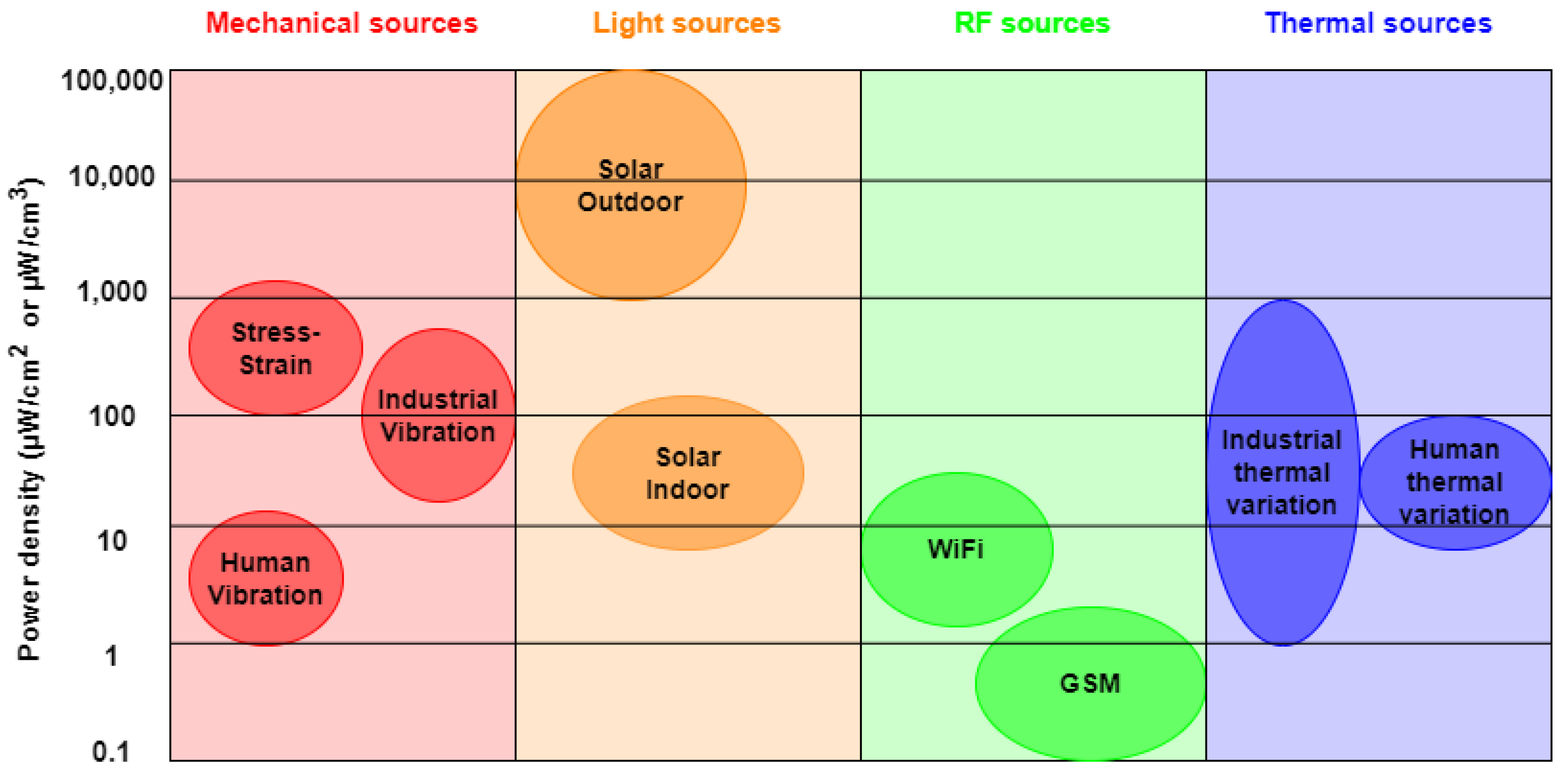


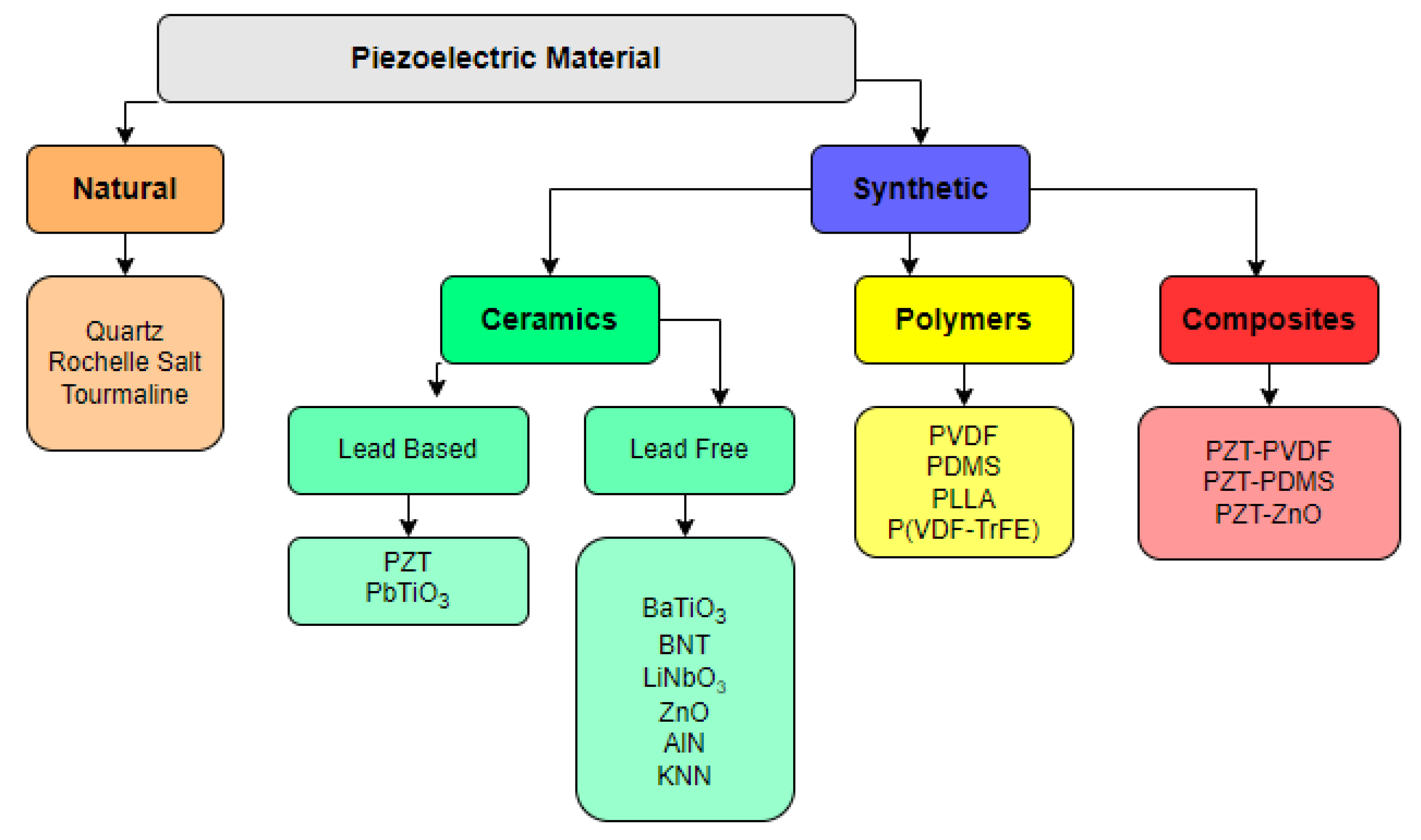
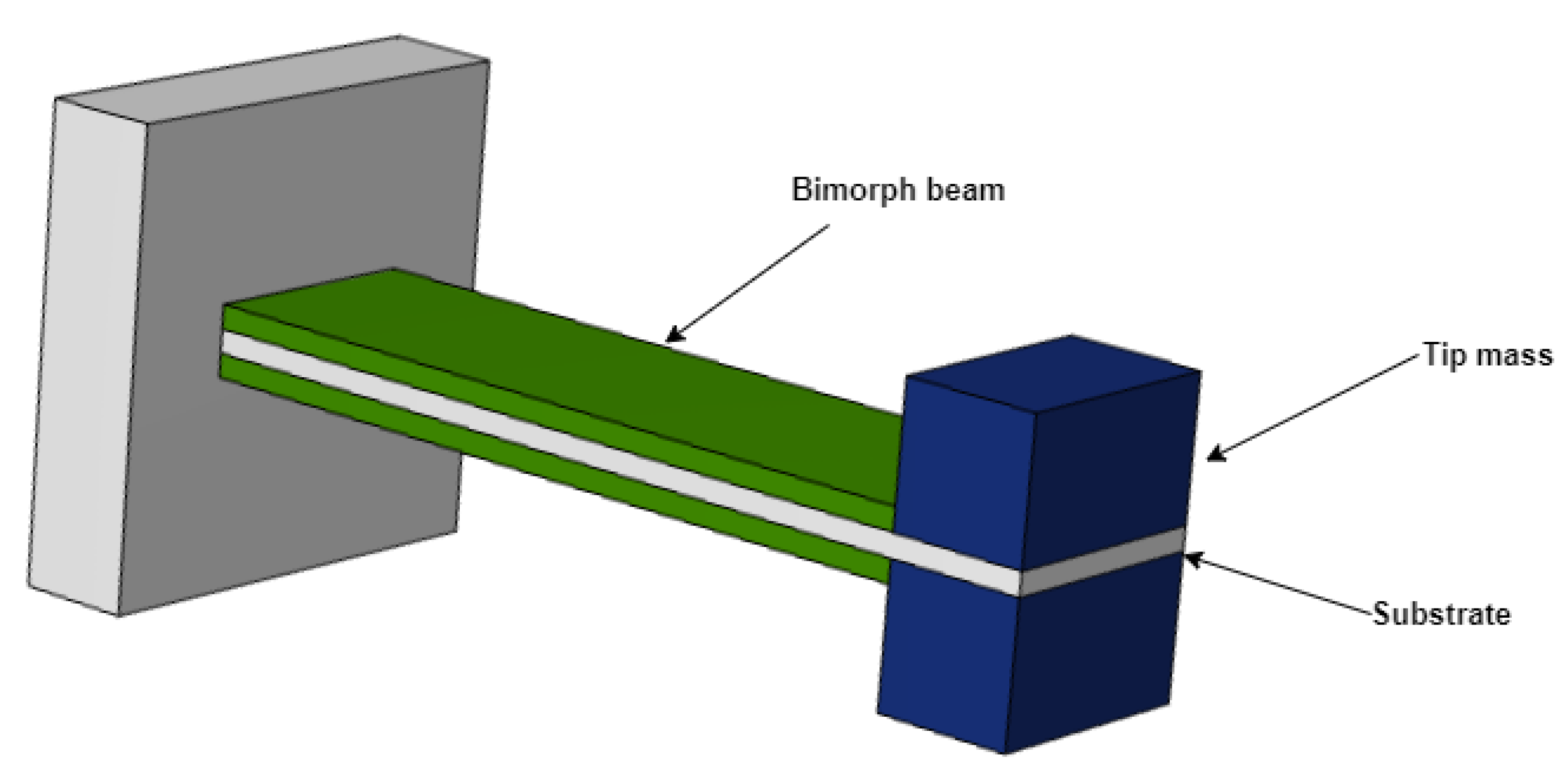
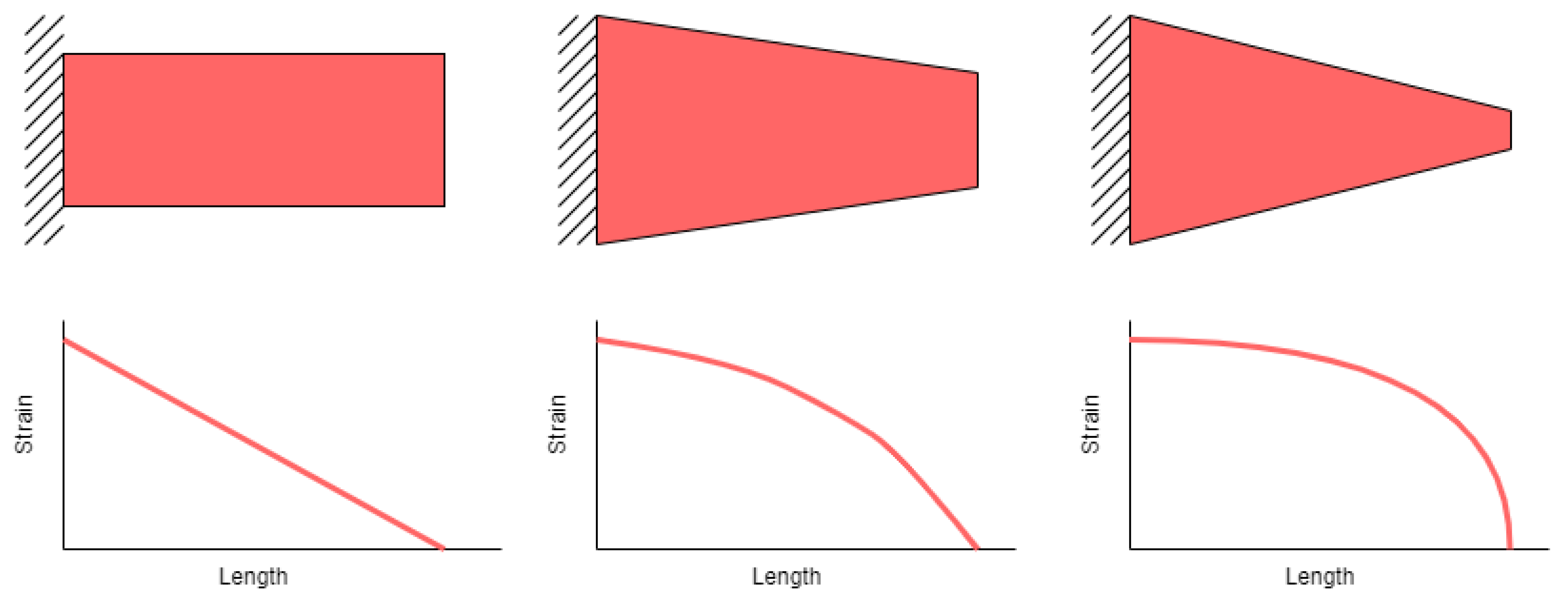


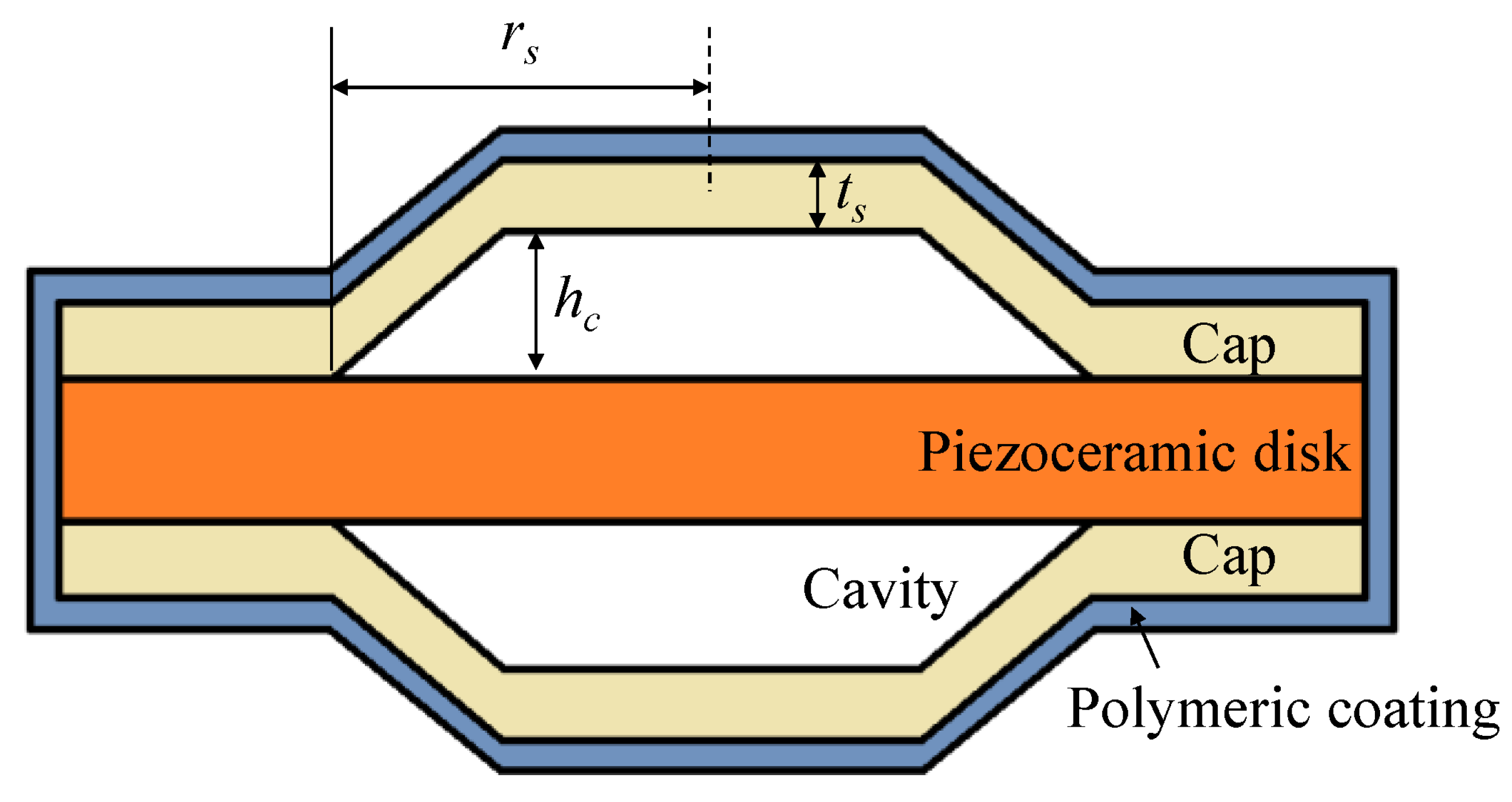
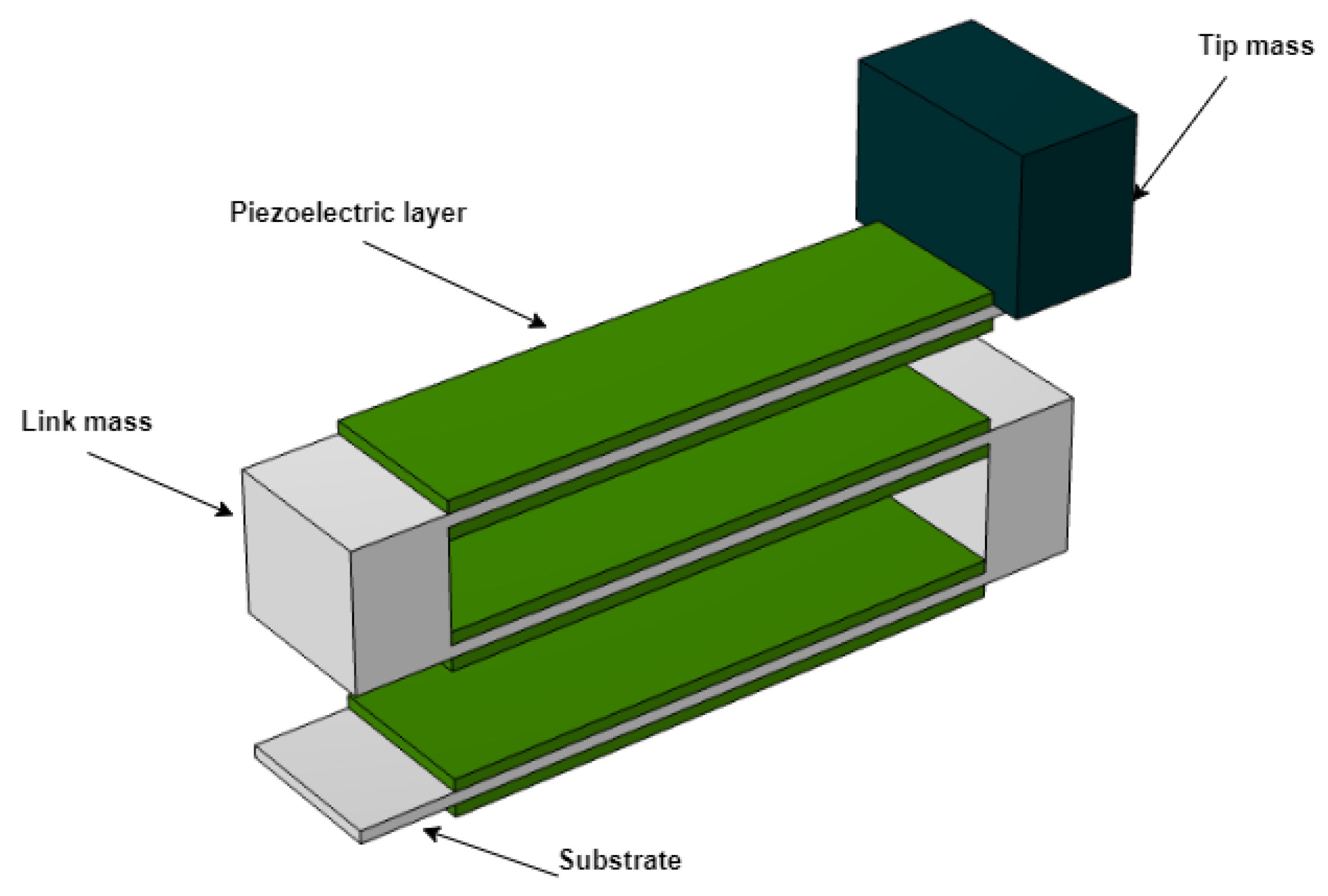



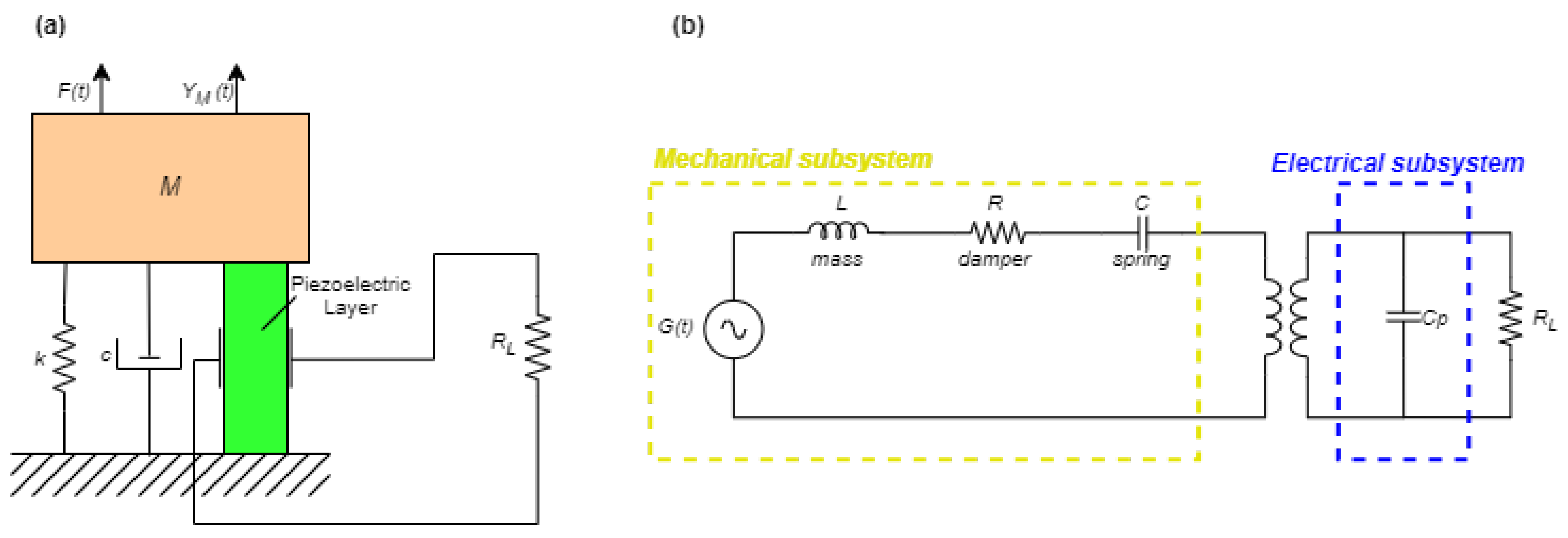
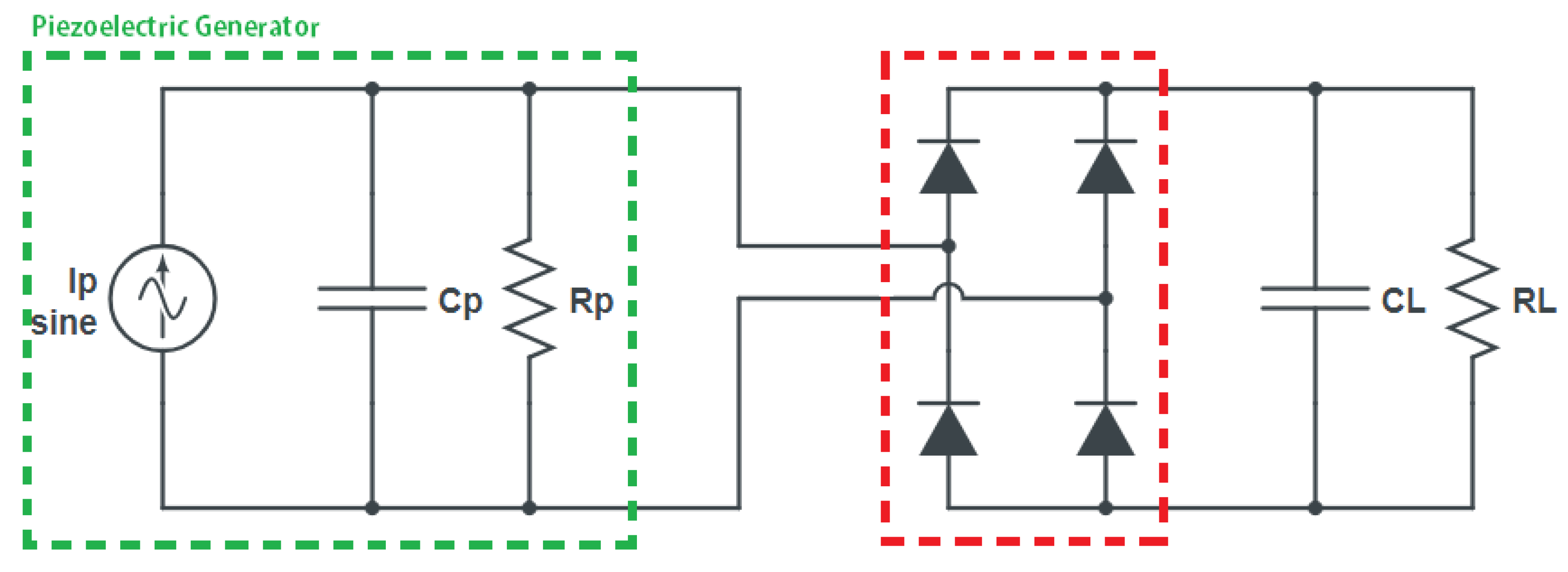


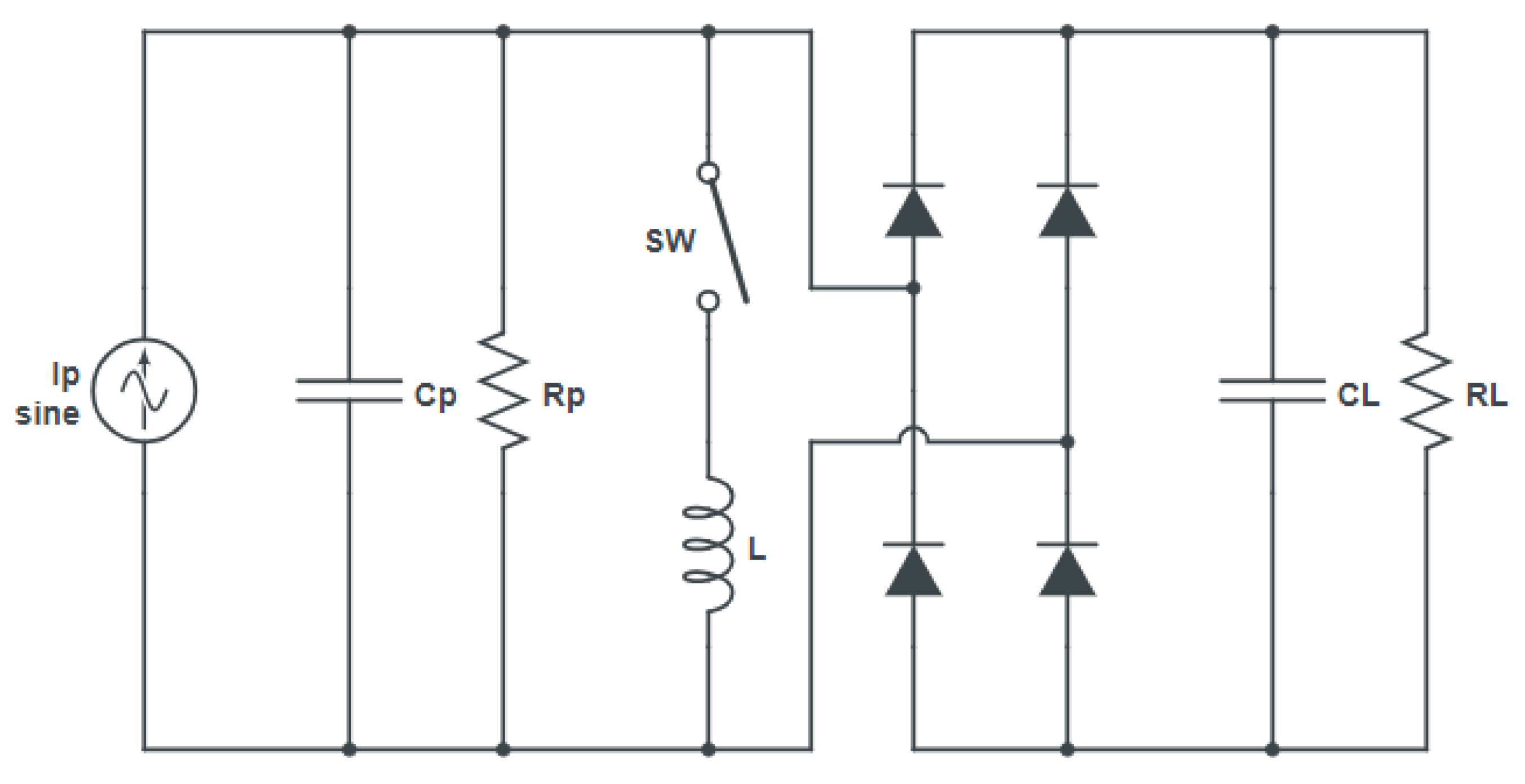
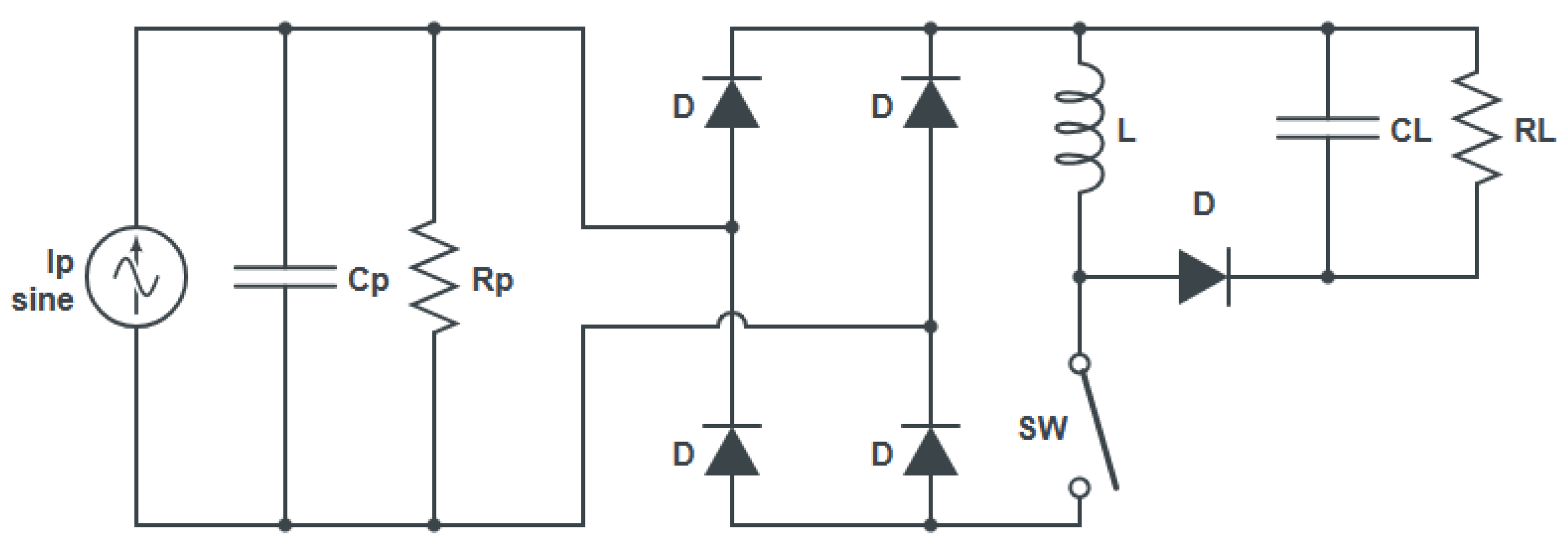

| Property | Ceramics | Polymers | Composites |
|---|---|---|---|
| Piezoelectric Constant (pC/N) | High (100–700) | Low (5–40) | High (50–200) |
| Electromechanical Coupling Factor | Medium (0.5–0.7) | Low (0.05–0.25) | High (0.4–0.8) |
| Curie Temperature (°C) | High (150–1000) | Low (−20–100) | Subjective (20–400) |
| Voltage Constant | High (10–30) | Low (1–5) | Subjective (1–20) |
| Flexibility | Low | High | Medium |
| Density () | High (7–8) | Low (1.5–2) | Medium (2–7) |
| Mechanical Quality Factor | High (500–2000) | Low (3–10) | High (50–1000) |
| Acoustic Impedance (MRayls) | High (20–30) | Low (1–5) | High (10–20) |
| Chemical Reactivity | Low | Subjective | Subjective |
| Feasibility of Manufacturing | High | High | Low |
| Cost | High | Low | Subjective |
| Type of Configuration | Advantages | Disadvantages |
|---|---|---|
| Cantilever beam | Simple structure | Inability to resist a high impact force |
| Low fabrication cost | ||
| Lower resonance frequency | ||
| Power output is proportional to proof mass | ||
| High mechanical quality factor | ||
| Circular diaphragm | Compatible with pressure mode operation | Stiffer than a cantilever of the same size |
| Higher resonance frequencies | ||
| Cymbal transducer | High energy output | |
| Withstands high impact force | Limited to applications demanding high magnitude vibration sources | |
| Stacked and array structures | Suitable for pressure mode operation | High stiffness |
| Higher output from d33 mode |
| Device Description | Dimensions | Output Performance | Ref. |
|---|---|---|---|
| Cantilever beam in PZT-5H | 60 × 31 × 0.2 mm3 | The peak output voltage is 18 V, and the electric power is 29 mW under excitation force 1 g and frequency 26.6 Hz. | [225] |
| PZT thin film on buffer-layer with PbTiO3 inter-layer | 800 × 100 × 10 μm3 | From a vibration of 0.39 g acceleration at its resonance frequency of 528 Hz, the built energy harvester generated 1.1 μW of electrical power with 4.4 V peak output voltage. | [226] |
| ZnO NW and a dielectric PE film on a wearable textile substrate | 10 cm2 | When activated by acoustic vibrations at 100 dB, the open-circuit voltage is 8 V and the short-circuit current density is 0.15 μA/cm2. | [227] |
| AlN-based piezoelectric devices | 1.01 × 5.0 × 5.0 mm | At 2.0 g acceleration and 572 Hz resonant frequency, the maximum output power is 60 μW. | [228] |
| P(VDF-TrFE) thin film | 0.09 cm2 | Nanogenerator has up to 7 V open-circuit voltage and 58 nA short-circuit current with a current density of 0.56 μA/cm2. | [229] |
| Electrospun PVDF/BaTiO3 nanogenerator | 2 cm × 6 cm × 50 μm | At the resonance frequency of 15.7 Hz, the highest piezoelectric output power was 0.243 W (15 wt% PVDF and 5 wt% BaTiO3), acetone/DMF (6:4 vol./vol.) under 10 MΩ. | [230] |
| Sea-sponge-inspired BCZT | When compressed by 12%, the output voltage is 25 V, the current density is 550 nA/cm2, and the power density is 2.6 mW/cm2. | [231] | |
| PLLA nanofibers | With a strain deformation angle of 28.9°, the open-circuit voltage is 0.55 V and the short-circuit current is 230 pA. The maximum electric power produced by human joint motion is 19.5 nW. | [232] | |
| Cellulose nanofibers/PDMS | The open-circuit voltage is 60.2 V, the short-circuit current is 10.1 A, and the power density is 6.3 mW/cm3 when the oscillator is excited at 10 Hz. | [233] |
Disclaimer/Publisher’s Note: The statements, opinions and data contained in all publications are solely those of the individual author(s) and contributor(s) and not of MDPI and/or the editor(s). MDPI and/or the editor(s) disclaim responsibility for any injury to people or property resulting from any ideas, methods, instructions or products referred to in the content. |
© 2023 by the authors. Licensee MDPI, Basel, Switzerland. This article is an open access article distributed under the terms and conditions of the Creative Commons Attribution (CC BY) license (https://creativecommons.org/licenses/by/4.0/).
Share and Cite
Brusa, E.; Carrera, A.; Delprete, C. A Review of Piezoelectric Energy Harvesting: Materials, Design, and Readout Circuits. Actuators 2023, 12, 457. https://doi.org/10.3390/act12120457
Brusa E, Carrera A, Delprete C. A Review of Piezoelectric Energy Harvesting: Materials, Design, and Readout Circuits. Actuators. 2023; 12(12):457. https://doi.org/10.3390/act12120457
Chicago/Turabian StyleBrusa, Eugenio, Anna Carrera, and Cristiana Delprete. 2023. "A Review of Piezoelectric Energy Harvesting: Materials, Design, and Readout Circuits" Actuators 12, no. 12: 457. https://doi.org/10.3390/act12120457
APA StyleBrusa, E., Carrera, A., & Delprete, C. (2023). A Review of Piezoelectric Energy Harvesting: Materials, Design, and Readout Circuits. Actuators, 12(12), 457. https://doi.org/10.3390/act12120457









